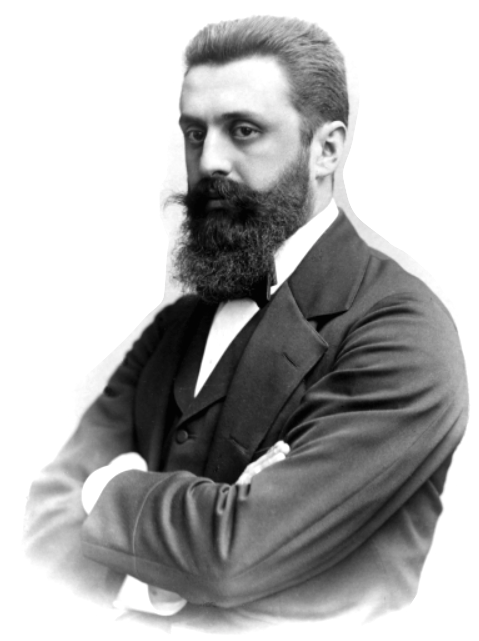
シオニズム
Zionism
Theodor
Herzl
☆ シオニズム(ヘブライ語: シオニズム(ヘブライ語: צִי ּוֹ Tsiyyonut [tsijoˈּ) は、19世紀に登場したナショナリスト運動であり、パレスチナにおけるユダヤ人のための祖国の樹立を支持する。 イスラエルの建国後、シオニズムは「イスラエル国家の発展と保護」を支持するイデオロギーとなった。シオニズムは当初、反ユダヤ主義の新たな波への反動と して、またハスカラ(ユダヤ啓蒙主義)への応答として、19世紀後半に国民復興運動として中東ヨー ロッパで出現した。この後すぐに、運動の指導者の多くは、当時オスマン帝国によって支配されていたパレスチナに望ましい祖国を創 設することを主な目標とした。このプロセスはシオニズム運動によって「亡命者の結集」(kibbutz galuyot)とみなされ、ユダヤ人を歴史的な祖国に帰還させることによってユダヤ人の歴史を特徴づけてきた追放と迫害に終止符を打つ取り組みであった。
| Zionism
(Hebrew: צִיּוֹנוּת Tsiyyonut [tsijoˈnut] after Zion) is a
nationalist[fn 1] movement that emerged in the 19th century to espouse
support for the establishment of a homeland for the Jewish people in
Palestine,[3][4][5][6] a region roughly corresponding to the Land of
Israel in Jewish tradition.[7][8][9][10] Following the establishment of
Israel, Zionism became an ideology that supports "the development and
protection of the State of Israel".[11] Zionism initially emerged in Central and Eastern Europe as a national revival movement in the late 19th century, both in reaction to newer waves of antisemitism and as a response to Haskalah, or Jewish Enlightenment.[12][13][14] Soon after this, most leaders of the movement associated the main goal with creating the desired homeland in Palestine, then an area controlled by the Ottoman Empire.[15][16][17] This process was seen by the Zionist Movement as an "ingathering of exiles" (kibbutz galuyot), an effort to put a stop to the exoduses and persecutions that have marked Jewish history by bringing the Jewish people back to their historic homeland.[18] From 1897 to 1948, the primary goal of the Zionist Movement was to establish the basis for a Jewish homeland in Palestine, and thereafter to consolidate it. In a unique variation of the principle of self-determination,[19] The Lovers of Zion united in 1884 and in 1897 the first Zionist congress was organized. In the late 19th and early 20th centuries, a large number of Jews immigrated to first Ottoman and later Mandatory Palestine, and at the same time, diplomatic attempts were made to gain worldwide recognition and support. Since the establishment of the State of Israel in 1948, Zionism has continued primarily to advocate on behalf of Israel and to address threats to its continued existence and security. Zionism has never been a uniform movement. Its leaders, parties, and ideologies frequently diverged from one another. Compromises and concessions were made in order to achieve a shared cultural and political objective as a result of the growing antisemitism and yearning to return to the "ancestral" country. A variety of types of Zionism have emerged, including political Zionism, liberal Zionism, labor Zionism, revisionist Zionism, cultural Zionism, and religious Zionism. Advocates of Zionism view it as a national liberation movement for the repatriation of a persecuted people to its ancestral homeland.[20][21][22] Critics of Zionism view it as a colonialist,[23] racist,[24] or exceptionalist ideology or movement.[25][26][27][28][29] |
シ
オニズム(ヘブライ語: シオニズム(ヘブライ語: צִי ּוֹ Tsiyyonut [tsijoˈּ)
は、19世紀に登場したナショナリスト運動[fn 1]であり、パレスチナにおけるユダヤ人のための祖国の樹立を支持する[3][4][5][6]。
[7][8][9][10]イスラエルの建国後、シオニズムは「イスラエル国家の発展と保護」を支持するイデオロギーとなった[11]。 シオニズムは当初、反ユダヤ主義の新たな波への反動として、またハスカラ(ユダヤ啓蒙主義)への応答として、19世紀後半に国民復興運動として中東ヨー ロッパで出現した[12][13][14]。この後すぐに、運動の指導者の多くは、当時オスマン帝国によって支配されていたパレスチナに望ましい祖国を創 設することを主な目標とした。 [15][16][17]このプロセスはシオニズム運動によって「亡命者の結集」(kibbutz galuyot)とみなされ、ユダヤ人を歴史的な祖国に帰還させることによってユダヤ人の歴史を特徴づけてきた追放と迫害に終止符を打つ取り組みであった [18]。 1897年から1948年まで、シオニスト運動の第一の目標は、パレスチナにユダヤ人の祖国の基礎を築き、その後それを強固なものにすることであった。自 決の原則のユニークなバリエーションとして[19]、シオンの恋人たちは1884年に団結し、1897年には最初のシオニスト会議が組織された。19世紀 後半から20世紀初頭にかけて、最初はオスマン帝国、後に委任統治時代のパレスチナに多くのユダヤ人が移住し、同時に世界的な認知と支持を得るための外交 的な試みが行われた。1948年にイスラエルが建国されて以来、シオニズムは主にイスラエルを擁護し、イスラエルの存続と安全に対する脅威に対処してき た。 シオニズムは決して一様な運動ではない。シオニズムの指導者、政党、イデオロギーは、しばしば互いに対立した。反ユダヤ主義が強まり、「祖国」への帰還を 切望するようになった結果、文化的・政治的目的を共有するために妥協や譲歩がなされた。政治シオニズム、自由主義シオニズム、労働シオニズム、修正主義シ オニズム、文化シオニズム、宗教シオニズムなど、さまざまなタイプのシオニズムが生まれた。シオニズムの擁護者は、シオニズムを迫害された民族を祖国へ送 還するための国民解放運動とみなしている[20][21][22]。シオニズムの批判者は、シオニズムを植民地主義、[23]人種差別主義、[24]例外 主義的な思想や運動とみなしている[25][26][27][28][29]。 |
| Terminology The term "Zionism" is derived from the word Zion (Hebrew: ציון, Tzi-yon), a hill in Jerusalem, widely symbolizing the Land of Israel.[30] Throughout eastern Europe in the late 19th century, numerous grassroots groups promoted the national resettlement of the Jews in their homeland,[31] as well as the revitalization and cultivation of the Hebrew language. These groups were collectively called the "Lovers of Zion" and were seen as countering a growing Jewish movement toward assimilation. The first use of the term is attributed to the Austrian Nathan Birnbaum, founder of the Kadimah nationalist Jewish students' movement; he used the term in 1890 in his journal Selbst-Emancipation (Self-Emancipation),[32][33] itself named almost identically to Leon Pinsker's 1882 book Auto-Emancipation.  Theodor Herzl was the founder of the Modern Zionist movement. In his 1896 pamphlet Der Judenstaat, he envisioned the founding of a future independent Jewish state during the 20th century.; |
用語解説 シオニズム」という言葉は、イスラエルの地を広く象徴するエルサレムの丘であるシオン(ヘブライ語: ציון, Tzi-yon)に由来する[30]。これらのグループは総称して「シオンの恋人たち」と呼ばれ、同化を目指すユダヤ人の動きの高まりに対抗するものと見 なされた。この言葉が最初に使われたのは、カディマのナショナリストユダヤ人学生運動の創始者であるオーストリア人のナタン・ビルンバウムであるとされて いる。彼は1890年に自身の雑誌『Selbst-Emancipation(自己解放)』[32][33]でこの言葉を用いており、それ自体はレオン・ ピンスカーが1882年に出版した『Auto-Emancipation(自己解放)』とほぼ同じ名前であった。  テ オドール・ヘルツルは近代シオニスト運動の創始者である。1896年に出版した小冊子『ユダヤ人国家(Der Judenstaat)』において、彼は20世紀中に将来の独立したユダヤ人国家を建国することを構想した。 |
| Overview Main article: Types of Zionism The common denominator among all Zionists has been a claim to Palestine, a land traditionally known in Jewish writings as the Land of Israel ("Eretz Israel") as a national homeland of the Jews and as the legitimate focus for Jewish national self-determination.[34] It is based on historical ties and religious traditions linking the Jewish people to the Land of Israel.[35] Zionism does not have a uniform ideology, but has evolved in a dialogue among a plethora of ideologies: General Zionism, Religious Zionism, Labor Zionism, Revisionist Zionism, Green Zionism, etc.  The flag of the Zionist Movement adopted in 1891 became the flag of the State of Israel, established in 1948. After almost two millennia of the Jewish diaspora residing in various countries without a national state, the Zionist movement was founded in the late 19th century by secular Jews, largely as a response by Ashkenazi Jews to rising antisemitism in Europe, exemplified by the Dreyfus affair in France and the anti-Jewish pogroms in the Russian Empire.[36] The political movement was formally established by the Austro-Hungarian journalist Theodor Herzl in 1897 following the publication of his book Der Judenstaat (The Jewish State).[37] At that time, the movement sought to encourage Jewish migration to Ottoman Palestine particularly among those Jewish communities who were poor, unassimilated and whose 'floating' presence caused disquiet, in Herzl's view, among assimilated Jews and stirred antisemitism among Christians.[38] "I believe that a wondrous generation of Jews will spring into existence. The Maccabeans will rise again. Let me repeat once more my opening words: The Jews who wish for a State will have it. We shall live at last as free men on our own soil, and die peacefully in our own homes. The world will be freed by our liberty, enriched by our wealth, magnified by our greatness. And whatever we attempt there to accomplish for our own welfare, will react powerfully and beneficially for the good of humanity." Theodor Herzl, concluding words of The Jewish State, 1896[39] Although initially one of several Jewish political movements offering alternative responses to Jewish assimilation and antisemitism, Zionism expanded rapidly. In its early stages, supporters considered setting up a Jewish state in the historic territory of Palestine. After World War II and the destruction of Jewish life in Central and Eastern Europe where these alternative movements were rooted, it became dominant in the thinking about a Jewish national state. Creating an alliance with Great Britain and securing support for some years for Jewish emigration to Palestine, Zionists also recruited European Jews to immigrate there, especially Jews who lived in areas of the Russian Empire where antisemitism was raging. The alliance with Britain was strained as the latter realized the implications of the Jewish movement for Arabs in Palestine, but the Zionists persisted. The movement was eventually successful in establishing Israel on May 14, 1948 (5 Iyyar 5708 in the Hebrew calendar), as the homeland for the Jewish people. The proportion of the world's Jews living in Israel has steadily grown since the movement emerged. By the early 21st century, more than 40% of the world's Jews lived in Israel, more than in any other country. These two outcomes represent the historical success of Zionism and are unmatched by any other Jewish political movement in the past 2,000 years. In some academic studies, Zionism has been analyzed both within the larger context of diaspora politics and as an example of modern national liberation movements.[40] Zionism also sought the assimilation of Jews into the modern world. As a result of the diaspora, many of the Jewish people remained outsiders within their adopted countries and became detached from modern ideas. So-called "assimilationist" Jews desired complete integration into European society. They were willing to downplay their Jewish identity and in some cases to abandon traditional views and opinions in an attempt at modernization and assimilation into the modern world. A less extreme form of assimilation was called cultural synthesis. Those in favor of cultural synthesis desired continuity and only moderate evolution, and were concerned that Jews should not lose their identity as a people. "Cultural synthesists" emphasized both a need to maintain traditional Jewish values and faith and a need to conform to a modernist society, for instance, in complying with work days and rules.[41] In 1975, the United Nations General Assembly passed Resolution 3379, which designated Zionism as "a form of racism and racial discrimination". The resolution was repealed in 1991 by replacing Resolution 3379 with Resolution 46/86.[42] |
概要 主な記事 シオニズムの種類 すべてのシオニストに共通するのは、ユダヤ人の国民的祖国として、またユダヤ人の民族自決の正当な焦点として、伝統的にイスラエルの地(「エレツ・イスラ エル」)としてユダヤ教の著作で知られてきたパレスチナへの主張である[34]。シオニズムは、ユダヤ人とイスラエルの地を結びつける歴史的な結びつきと 宗教的伝統に基づいている[35]。シオニズムは統一されたイデオロギーを持っているわけではなく、多数のイデオロギーの対話の中で発展してきた: 一般シオニズム、宗教シオニズム、労働シオニズム、修正主義シオニズム、緑のシオニズムなどである。  1891年に採択されたシオニズム運動の旗は、1948年に樹立されたイスラエル国家の旗となった。 シオニズム運動は、フランスのドレフュス事件やロシア帝国の反ユダヤポグロムに代表されるヨーロッパの反ユダヤ主義の高まりに対するアシュケナージ・ユダ ヤ人の反応として、19世紀後半に世俗的なユダヤ人によって創設された。 [この政治運動は、1897年にオーストリア=ハンガリーのジャーナリストであるテオドール・ヘルツルによって、彼の著書『ユダヤ人国家』(Der Judenstaat)の出版後に正式に設立された[37]。当時、この運動は、オスマン・パレスチナへのユダヤ人の移住を奨励しようとするもので、特 に、貧しく、同化しておらず、「浮遊」しているユダヤ人コミュニティの存在が、同化したユダヤ人の間に不穏な空気をもたらし、キリスト教徒の間に反ユダヤ 主義をかき立てたというのがヘルツルの見解であった[38]。 「私はユダヤ人の不思議な世代が誕生すると信じている。マカベ人が再び立ち上がるのだ。冒頭の言葉をもう一度繰り返そう: 国家を望むユダヤ人はそれを手に入れるだろう。われわれはついに、自らの土地で自由人として生き、自らの家で安らかに死ぬであろう。世界はわれわれの自由 によって解放され、われわれの富によって豊かになり、われわれの偉大さによって拡大する。そして、われわれがそこで自分たちの幸福のために成し遂げようと することは何でも、人類の利益のために力強く有益に反応するだろう」。 テオドール・ヘルツル、『ユダヤ国家』の結びの言葉、1896年[39]。 当初は、ユダヤ人の同化と反ユダヤ主義に対する代替案を提示するいくつかのユダヤ人政治運動のひとつであったが、シオニズムは急速に拡大した。初期の段階 では、支持者たちは歴史的な領土であるパレスチナにユダヤ人国家を樹立することを考えていた。第二次世界大戦後、これらの代替運動が根付いていた中欧や東 欧でユダヤ人の生活が破壊された後、シオニズムはユダヤ人の国家を考える上で支配的な存在となった。 シオニストはイギリスと同盟を結び、パレスチナへのユダヤ人移住を何年かにわたって支援し、ヨーロッパのユダヤ人、特に反ユダヤ主義が猛威を振るっていた ロシア帝国の地域に住んでいたユダヤ人をパレスチナに移住させた。イギリスとの同盟関係は、ユダヤ人運動がパレスチナのアラブ人に与える影響に気づいたイ ギリスが緊張を強いる中、シオニストは粘り強く活動を続けた。この運動は最終的に成功し、1948年5月14日(ヘブライ暦5708年5月5日)、ユダヤ 人の祖国としてイスラエルを建国した。この運動が勃興して以来、イスラエルに住む世界のユダヤ人の割合は着実に増加している。21世紀初頭には、世界のユ ダヤ人の40%以上がイスラエルに住み、他のどの国よりも多くなった。これら2つの結果は、シオニズムの歴史的成功を象徴するものであり、過去2,000 年間における他のどのユダヤ人の政治運動とも比較にならない。いくつかの学術研究では、シオニズムはディアスポラ政治という大きな文脈の中でも、近代的な 民族解放運動の一例としても分析されている[40]。 シオニズムはまた、ユダヤ人の現代世界への同化を求めた。ディアスポラの結果、ユダヤ人の多くは自国内でアウトサイダーであり続け、近代的な思想から切り 離された存在となった。いわゆる「同化主義」のユダヤ人は、ヨーロッパ社会への完全な統合を望んだ。彼らはユダヤ人としてのアイデンティティを軽視し、場 合によっては伝統的な考え方や意見を捨ててでも、近代化と現代世界への同化を図ろうとした。同化の極端でない形態は文化的統合と呼ばれた。文化的統合を支 持する人々は、継続性と適度な進化を望み、ユダヤ人が民(people)としてのアイデンティティを失ってはならないと懸念した。「文化的統合主義者」 は、伝統的なユダヤ人の価値観や信仰を維持する必要性と、例えば労働日や規則を遵守するなど近代主義社会に適合する必要性の両方を強調した[41]。 1975年、国連総会はシオニズムを「人種主義および人種差別の一形態」とする決議3379を可決した。この決議は1991年に決議3379を決議 46/86に置き換えて廃止された[42]。 |
| Beliefs Main articles: Return to Zion, Sabra (person), Aliyah, Racial antisemitism, New antisemitism, Religious antisemitism, and Revival of the Hebrew language See also: Yiddish, Ladino language, and Hebraization of surnames In 1896, Theodor Herzl expressed in Der Judenstaat his views on "the restoration of the Jewish state".[43] Herzl considered Antisemitism to be an eternal feature of all societies in which Jews lived as minorities, and that only a sovereignty could allow Jews to escape eternal persecution : "Let them give us sovereignty over a piece of the Earth's surface, just sufficient for the needs of our people, then we will do the rest!" he proclaimed exposing his plan.[44]: 27, 29 Aliyah (migration, literally "ascent") to the Land of Israel is a recurring theme in Jewish prayers. Ethnic unity and descent from Biblical Jews Main article: Zionism, race and genetics Early Zionists were the primary Jewish supporters of the idea that Jews are a race, as it "offered scientific 'proof' of the ethno-nationalist myth of common descent".[45] This "racialisation of Jewish identity in the rhetoric of the founders of Zionism" was originally a reaction to European antisemitism.[46] According to Raphael Falk, as early as the 1870s, contrary to largely cultural perspectives among integrated and assimilated Jewish communities in the Age of Enlightenment and Age of Romanticism, "the Zionists-to-be stressed that Jews were not merely members of a cultural or a religious entity, but were an integral biological entity".[47] This re-conceptualization of Jewishness cast the "volk" of the Jewish community as a nation-race, in contrast to centuries-old conceptions of the Jewish people as a religious socio-cultural grouping.[47] It was particularly important in early nation building in Israel, because Jews in Israel are ethnically diverse and the origins of Ashkenazi Jews, the original founders of Zionism, are "highly debated and enigmatic".[48][49] Notable proponents of this included Max Nordau, Herzl's co-founder of the original Zionist Organization, Ze'ev Jabotinsky, the prominent architect of early statist Zionism and the founder of what became Israel's Likud party,[50] and Arthur Ruppin, considered the "father of Israeli sociology".[51] Jabotinsky wrote that Jewish national integrity relies on “racial purity", whereas Nordau asserted the need for an "exact anthropological, biological, economic, and intellectual statistic of the Jewish people".[50] According to Hassan S. Haddad, the application of the Biblical concepts of Jews as the chosen people and the "Promised Land" in Zionism, particularly to secular Jews, requires the belief that modern Jews are the primary descendants of biblical Jews and Israelites.[52] This is considered important to the State of Israel, because its founding narrative is based on the biblical concept of "Gathering of the exiles" and the "Return to Zion", on the assumption that modern Jews are the primary descendants of the Jews of the biblical stories.[53] The question has thus been focused on by supporters of Zionism and anti-Zionists alike,[54] as in this absence of this biblical primacy, "the Zionist project falls prey to the pejorative categorization as ‘settler colonialism’ pursued under false assumptions, playing into the hands of Israel's critics and fueling the indignation of the displaced and stateless Palestinian people,"[53] whilst right-wing Israelis look for "a way of proving the occupation is legitimate, of authenticating the ethnos as a natural fact, and of defending Zionism as a return".[55] A Jewish "biological self-definition" has become a standard belief for many Jewish nationalists, and most Israeli population researchers have never doubted that evidence will one day be found, even though so far such facts have "remained forever elusive".[56] Negation of the life in the Diaspora Negation of life in the Diaspora is a central assumption in Zionism.[57][58][59][60] Some supporters of Zionism believed that Jews in the Diaspora were prevented from their full growth in Jewish individual and national life.[citation needed] The rejection of life in the diaspora was not limited to secular Zionism; many religious Zionists shared this opinion, but not all religious Zionism did. Rav Cook, considered one of the most important religious Zionist thinkers, characterized the diaspora as a flawed and alienated existence marked by decline, narrowness, displacement, solitude, and frailty. He believed that the diasporan way of life is diametrically opposed to a "national renaissance," which manifests itself not only in the return to Zion but also in the return to nature and creativity, revival of heroic and aesthetic values, and the resurgence of individual and societal power.[61] Revival of the Hebrew language Main article: Revival of the Hebrew language See also: Modern Hebrew and Hebraization of surnames 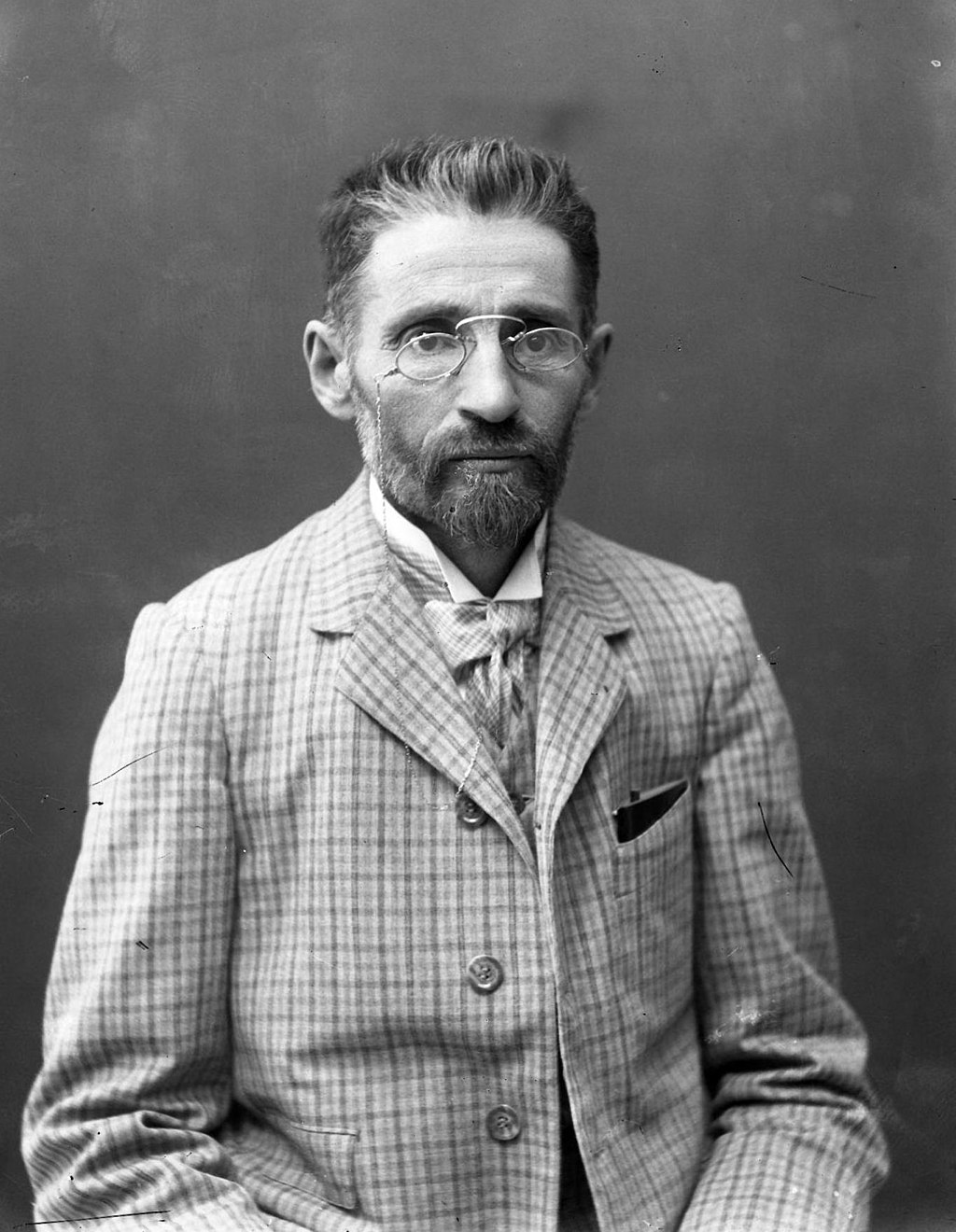 Eliezer Ben-Yehuda (1858–1922), founder and leader of the movement to revive the Hebrew language, is considered the father of Modern Hebrew.[62] Zionists generally preferred to speak Hebrew, a Semitic language which flourished as a spoken language in the ancient Kingdoms of Israel and Judah during the period from about 1200 to 586 BCE,[63] and continued to be used in some parts of Judea during the Second Temple period and up until 200 CE. It is the language of the Hebrew Bible and the Mishnah, central texts in Judaism. Hebrew was largely preserved throughout later history as the main liturgical language of Judaism. Zionists worked to modernize Hebrew and adapt it for everyday use. They sometimes refused to speak Yiddish, a language they thought had developed in the context of European persecution. Once they moved to Israel, many Zionists refused to speak their (diasporic) mother tongues and adopted new, Hebrew names. Hebrew was preferred not only for ideological reasons, but also because it allowed all citizens of the new state to have a common language, thus furthering the political and cultural bonds among Zionists.[citation needed] The revival of the Hebrew language and the establishment of Modern Hebrew is most closely associated with the Russian linguist Eliezer Ben-Yehuda and the Committee of the Hebrew Language (later replaced by the Academy of the Hebrew Language).[64] In the Israeli Declaration of Independence Major aspects of the Zionist idea are represented in the Israeli Declaration of Independence: The Land of Israel was the birthplace of the Jewish people. Here their spiritual, religious and political identity was shaped. Here they first attained to statehood, created cultural values of national and universal significance and gave to the world the eternal Book of Books. After being forcibly exiled from their land, the people kept faith with it throughout their Dispersion and never ceased to pray and hope for their return to it and for the restoration in it of their political freedom. Impelled by this historic and traditional attachment, Jews strove in every successive generation to re-establish themselves in their ancient homeland. In recent decades they returned in their masses.[65] |
信念 主な記事 シオンへの回帰、サブラ(人)、アリア、人種的反ユダヤ主義、新しい反ユダヤ主義、宗教的反ユダヤ主義、ヘブライ語の復興 以下も参照: イディッシュ語、ラディーノ語、姓のヘブライ化 1896年、テオドール・ヘルツルは『ユダヤ人国家』(Der Judenstaat)で「ユダヤ人国家の回復」についての見解を表明した[43]。ヘルツルは、反ユダヤ主義はユダヤ人が少数派として生きるすべての社 会の永遠の特徴であり、主権のみがユダヤ人が永遠の迫害から逃れることを可能にすると考えた。 イスラエルの地へのアリア(移住、文字通り「昇天」)は、ユダヤ教の祈りの中で繰り返し語られるテーマである。 民族の統一と聖書のユダヤ人の子孫 主な記事 シオニズム、人種、遺伝 初期のシオニストはユダヤ人が人種であるという考えを支持するユダヤ人の第一人者であり、それは「共通の子孫というエスノナショナリストの神話に科学的な "証拠 "を与える」ものであった[45]。 [ラファエル・ファルクによれば、1870年代には、啓蒙主義の時代やロマン主義の時代に統合され同化されたユダヤ人コミュニティにおける主として文化的 な視点に反して、「シオニストとなるべき者たちは、ユダヤ人は単に文化的あるいは宗教的な存在の一員ではなく、一体化した生物学的な存在であると強調し た」[47]。このユダヤ人としての再認識は、宗教的な社会文化的集団としてのユダヤ人に対する何世紀にもわたる概念とは対照的に、ユダヤ人コミュニティ の「ヴォルク」を国民=人種として投げかけた[47]。 イスラエルのユダヤ人は民族的に多様であり、シオニズムの創始者であるアシュケナージ・ユダヤ人の出自は「非常に議論されており、謎に包まれている」た め、イスラエルにおける初期の国家建設において特に重要であった。 [48][49]著名な支持者には、初代シオニスト組織の共同創設者であるヘルツルのマックス・ノルダウ、初期の国家主義シオニズムの著名な立役者であ り、イスラエルのリクード党となったものの創設者であるゼエヴ・ジャボチンスキー[50]、「イスラエル社会学の父」とされるアーサー・ルッピンなどがい た。 [51]ジャボチンスキーはユダヤ人の民族的完全性は「人種的純粋性」に依存していると書いており、ノルダウは「ユダヤ人の正確な人類学的、生物学的、経 済的、知的統計」の必要性を主張していた[50]。 ハッサン・S・ハダドによれば、シオニズム、特に世俗的なユダヤ人に対して、ユダヤ人が選ばれた民であり「約束の地」であるという聖書の概念を適用するに は、現代のユダヤ人が聖書のユダヤ人およびイスラエル人の主要な子孫であるという信念が必要である。 イスラエル建国の物語が聖書の「流浪の民の結集」と「シオンへの帰還」という概念に基づいており、現代のユダヤ人が聖書の物語に登場するユダヤ人の主要な 子孫であるという前提に立っているためである[52]。 [この問題はシオニズム支持者にも反シオニストにも注目されており[54]、この聖書的な優位性がない場合、「シオニズムのプロジェクトは、誤った仮定の 下で追求される『入植者の植民地主義』という侮蔑的なカテゴライズの餌食になる、 イスラエルの右派は「占領が正当であることを証明する方法、民族を自然な事実として認証する方法、帰還としてのシオニズムを擁護する方法」を探している。 [ユダヤ人の「生物学的自己定義」は多くのユダヤ人ナショナリストにとって標準的な信念となっており、イスラエルの人口研究者の多くは、これまでのところ そのような事実が「永遠にとらえどころのないまま」であるにもかかわらず、いつかその証拠が発見されると信じて疑わなかった[56]。 ディアスポラでの生活の否定 ディアスポラでの生活の否定はシオニズムにおける中心的な仮定である[57][58][59][60]。シオニズムの支持者の中には、ディアスポラにいる ユダヤ人はユダヤ人の個人的・国民的生活における完全な成長を妨げられていると考える者もいた[要出典]。 ディアスポラでの生活の拒絶は世俗的シオニズムに限ったことではなく、多くの宗教的シオニストもこの意見を共有していたが、すべての宗教的シオニズムがそ うであったわけではない。宗教シオニストの最も重要な思想家の一人とされるラヴ・クックは、ディアスポラを、衰退、狭さ、居場所のなさ、孤独、虚弱さを特 徴とする欠陥のある疎外された存在として特徴づけた。彼は、ディアスポラの生き方は「民族のルネサンス」とは正反対であり、それはシオンへの回帰だけでな く、自然と創造性への回帰、英雄的・美的価値の復活、個人と社会の力の復活においても現れると考えた[61]。 ヘブライ語の復興 主な記事 ヘブライ語の復興 以下も参照: 現代ヘブライ語、苗字のヘブライ化  ヘブライ語復興運動の創始者であり指導者であったエリエゼル・ベン・イェフダ(1858~1922年)は、現代ヘブライ語の父と考えられている[62]。 シオニストは一般的にヘブライ語を話すことを好んだ。ヘブライ語はセム語で、紀元前1200年頃から586年頃までの間、古代イスラエル王国とユダ王国で 話し言葉として栄え[63]、第二神殿時代から紀元200年までユダの一部で使われ続けた。ヘブライ語はユダヤ教の中心的なテキストであるヘブライ語聖書 とミシュナーの言語である。ヘブライ語は、ユダヤ教の主要な典礼言語として、後世の歴史を通してほぼ守られてきた。 シオニストはヘブライ語を近代化し、日常的に使用できるようにした。彼らは、ヨーロッパの迫害の中で発達したと考えられるイディッシュ語を話すことを拒否 することもあった。イスラエルに移住すると、多くのシオニストは(ディアスポラ的な)母語を話すことを拒否し、ヘブライ語の新しい名前を採用した。ヘブラ イ語が好まれたのは、イデオロギー的な理由だけでなく、新国家の全市民が共通語を持つことができ、シオニスト間の政治的・文化的な結びつきが強まったから である[要出典]。 ヘブライ語の復興と現代ヘブライ語の確立は、ロシアの言語学者エリエゼル・ベン・イェフダとヘブライ語委員会(後にヘブライ語アカデミーに改称)と最も密 接な関係がある[64]。 イスラエル独立宣言において シオニズム思想の主要な側面はイスラエル独立宣言に表れている: イスラエルの地はユダヤ民族の発祥の地である。ここで彼らの精神的、宗教的、政治的アイデンティティが形成された。ここで彼らは初めて国家としての地位を 獲得し、国家的かつ普遍的な意義を持つ文化的価値を創造し、永遠の書物を世界にもたらした。 強制的に土地を追放された後も、人々は離散の間中、この土地への信仰を持ち続け、この土地への帰還と、この土地における政治的自由の回復への祈りと希望を 絶やすことはなかった。 この歴史的、伝統的な愛着に突き動かされるように、ユダヤ人は世代を重ねるごとに、古の祖国に自らを再確立しようと努力した。ここ数十年、彼らは大量に帰 還した[65]。 |
| Historical and religious
background Main articles: Jewish history, History of Israel, History of Palestine, and History of the Jews and Judaism in the Land of Israel The Jewish people are an ethnoreligious group and nation[66][67] originating from the Israelites[68][69][70] and Hebrews[71][72] of historical Israel and Judah, two Israelite kingdoms that emerged in the Southern Levant during the Iron Age. Jews are named after the Kingdom of Judah,[73][74][75] the southern of the two kingdoms, which was centered in Judea with its capital in Jerusalem.[76] The Kingdom of Judah was conquered by Nebuchadnezzar II of the Neo-Babylonian Empire in 586 BCE.[77] The Babylonians destroyed Jerusalem and the First Temple, which was at the center of ancient Judean worship. The Judeans were subsequently exiled to Babylon, in what is regarded as the first Jewish diaspora. "Hezekiah ... king of Judah" – Royal seal written in the Paleo-Hebrew alphabet, unearthed in Jerusalem Seventy years later, after the conquest of Babylon by the Persian Achaemenid Empire, Cyrus the Great allowed the Jews to return to Jerusalem and rebuild the Temple. This event came to be known as the Return to Zion. Under Persian rule, Judah became a self-governing Jewish province. After centuries of Persian and Hellenistic rule, the Jews regained their independence in the Maccabean Revolt against the Seleucid Empire, which led to the establishment of the Hasmonean Kingdom in Judea. It later expanded over much of modern Israel, and into some parts of Jordan and Lebanon.[78][79][80] The Hasmonean Kingdom became a client state of the Roman Republic in 63 BCE, and in 6 CE, was incorporated into the Roman Empire as the province of Judaea.[81] During the Great Jewish Revolt (66–73 CE), the Romans destroyed Jerusalem and burned the Second Temple.[82] Of the 600,000 (Tacitus) or 1,000,000 (Josephus) Jews of Jerusalem, all of them either died of starvation, were killed or were sold into slavery.[83] The Bar Kokhba Revolt (132–136 CE) led to the destruction of large parts of Judea, and many Jews were killed, exiled, or sold into slavery. The province of Judaea was renamed Syria Palaestina. These actions are seen by many scholars as an attempt to disconnect the Jewish people from their homeland.[84][85] In the following centuries, many Jews emigrated to thriving centers in the diaspora. Others continued living in the region, especially in the Galilee, the coastal plain, and on the edges of Judea, and some converted.[86][87] By the fourth century CE, the Jews, who had previously constituted the majority of Palestine, had become a minority.[88] A small presence of Jews has been attested for almost all of the period. For example, according to tradition, the Jewish community of Peki'in has maintained a Jewish presence since the Second Temple period.[89][90] Coin of the Bar-Kokhba revolt (132–135 CE). Front shows trumpets surrounded by "To the freedom of Jerusalem". Back shows a lyre surrounded by "Year two to the freedom of Israel" Jewish religious belief holds that the Land of Israel is a God-given inheritance of the Children of Israel based on the Torah, particularly the books of Genesis and Exodus, as well as on the later Prophets.[91][92][93] According to the Book of Genesis, Canaan was first promised to Abraham's descendants; the text is explicit that this is a covenant between God and Abraham for his descendants.[94] The belief that God had assigned Canaan to the Israelites as a Promised Land is also conserved also in Christian[95] and Islamic traditions.[96] Among Jews in the Diaspora, the Land of Israel was revered in a cultural, national, ethnic, historical, and religious sense. They thought of a return to it in a future messianic age.[97] Return to Zion remained a recurring theme among generations, particularly in Passover and Yom Kippur prayers, which traditionally concluded with "Next year in Jerusalem", and in the thrice-daily Amidah (Standing prayer).[98] The biblical prophecy of Kibbutz Galuyot, the ingathering of exiles in the Land of Israel as foretold by the Prophets, became a central idea in Zionism.[99][100][101] Pre-Zionist initiatives The 15th-century Abuhav synagogue, established by Sephardic Jews in Safed, Northern Israel.[102][better source needed] In the middle of the 16th century, the Portuguese Sephardi Joseph Nasi, with the support of the Ottoman Empire, tried to gather the Portuguese Jews, first to migrate to Cyprus, then owned by the Republic of Venice, and later to resettle in Tiberias. Nasi—who never converted to Islam[103][104]—eventually obtained the highest medical position in the empire, and actively participated in court life. He convinced Suleiman I to intervene with the Pope on behalf of Ottoman-subject Portuguese Jews imprisoned in Ancona.[103] Between the 4th and 19th centuries, Nasi's was the only practical attempt to establish some sort of Jewish political center in Palestine.[105][better source needed] In the 17th century Sabbatai Zevi (1626–1676) announced himself as the Messiah and gained many Jews to his side, forming a base in Salonika. He first tried to establish a settlement in Gaza, but moved later to Smyrna. After deposing the old rabbi Aaron Lapapa in the spring of 1666, the Jewish community of Avignon, France prepared to emigrate to the new kingdom. The readiness of the Jews of the time to believe the messianic claims of Sabbatai Zevi may be largely explained by the desperate state of Central European Jewry in the mid-17th century. The bloody pogroms of Bohdan Khmelnytsky had wiped out one-third of the Jewish population and destroyed many centers of Jewish learning and communal life.[106] In the early 19th century, a group of Jews known as the perushim left Lithuania to settle in Ottoman Palestine. Establishment of the Zionist movement In the 19th century, a current in Judaism supporting a return to Zion grew in popularity,[107] particularly in Europe, where antisemitism and hostility toward Jews were growing. The idea of returning to Palestine was rejected by the conferences of rabbis held in that epoch. Individual efforts supported the emigration of groups of Jews to Palestine, pre-Zionist Aliyah, even before the First Zionist Congress in 1897, the year considered as the start of practical Zionism.[108] Reform Jews rejected this idea of a return to Zion. The conference of rabbis held at Frankfurt am Main over July 15–28, 1845, deleted from the ritual all prayers for a return to Zion and a restoration of a Jewish state. The Philadelphia Conference, 1869, followed the lead of the German rabbis and decreed that the Messianic hope of Israel is "the union of all the children of God in the confession of the unity of God". In 1885 the Pittsburgh Conference reiterated this interpretation of the Messianic idea of Reform Judaism, expressing in a resolution that "we consider ourselves no longer a nation, but a religious community; and we therefore expect neither a return to Palestine, nor a sacrificial worship under the sons of Aaron, nor the restoration of any of the laws concerning a Jewish state".[109] 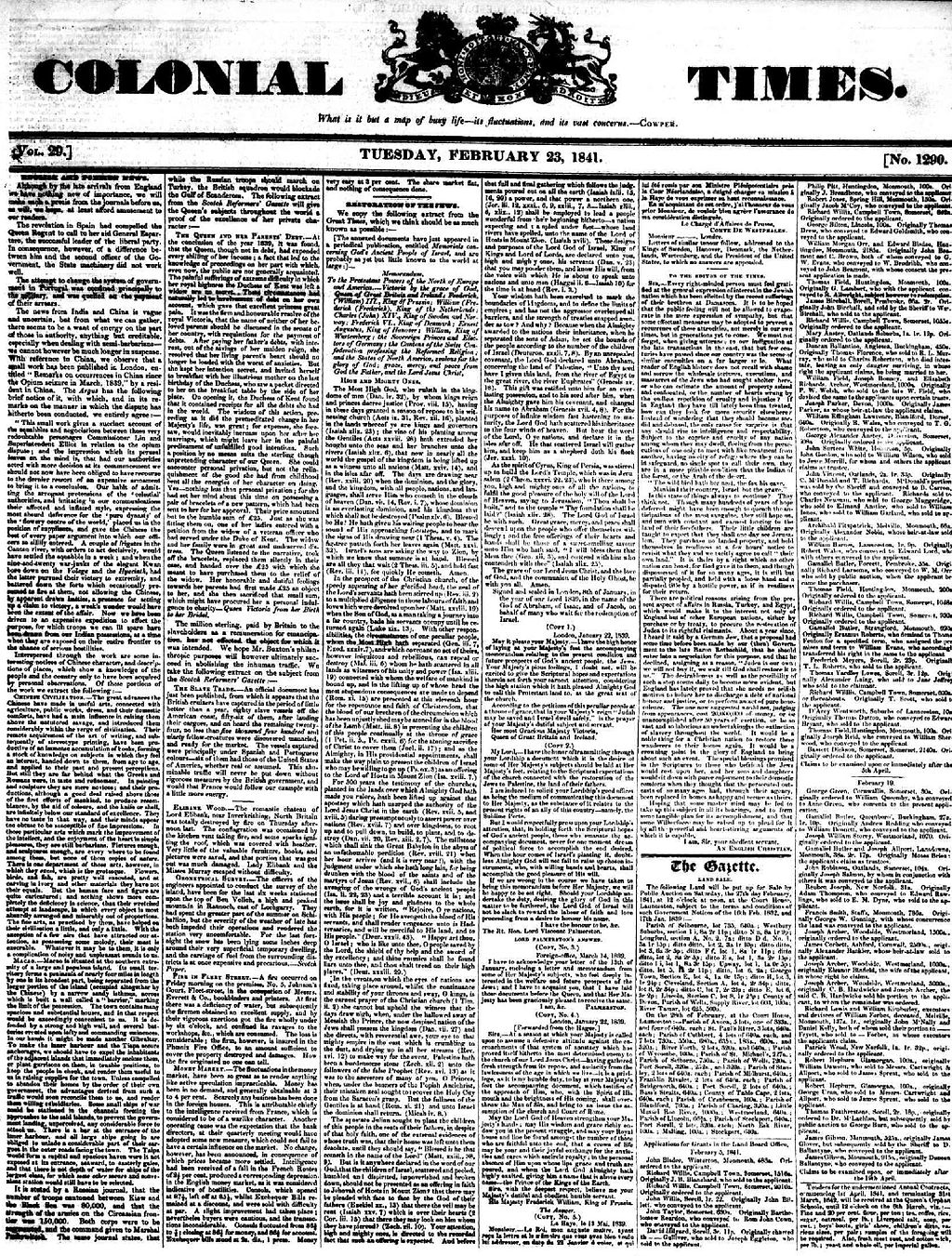 "Memorandum to the Protestant Powers of the North of Europe and America", published in the Colonial Times (Hobart, Tasmania, Australia), in 1841 Jewish settlements were proposed for establishment in the upper Mississippi region by W.D. Robinson in 1819.[110] Others were developed near Jerusalem in 1850, by the American Consul Warder Cresson, a convert to Judaism. Cresson was tried and condemned for lunacy in a suit filed by his wife and son. They asserted that only a lunatic would convert to Judaism from Christianity. After a second trial, based on the centrality of American 'freedom of faith' issues and antisemitism, Cresson won the bitterly contested suit.[111] He emigrated to Ottoman Palestine and established an agricultural colony in the Valley of Rephaim of Jerusalem. He hoped to "prevent any attempts being made to take advantage of the necessities of our poor brethren ... (that would) ... FORCE them into a pretended conversion."[112][better source needed] Moral but not practical efforts were made in Prague to organize a Jewish emigration, by Abraham Benisch and Moritz Steinschneider in 1835. In the United States, Mordecai Noah attempted to establish a Jewish refuge opposite Buffalo, New York, on Grand Isle, 1825. These early Jewish nation building efforts of Cresson, Benisch, Steinschneider and Noah failed.[113][page needed][114] Sir Moses Montefiore, famous for his intervention in favor of Jews around the world, including the attempt to rescue Edgardo Mortara, established a colony for Jews in Palestine. In 1854, his friend Judah Touro bequeathed money to fund Jewish residential settlement in Palestine. Montefiore was appointed executor of his will, and used the funds for a variety of projects, including building in 1860 the first Jewish residential settlement and almshouse outside of the old walled city of Jerusalem—today known as Mishkenot Sha'ananim. Laurence Oliphant failed in a like attempt to bring to Palestine the Jewish proletariat of Poland, Lithuania, Romania, and the Turkish Empire (1879 and 1882). The official beginning of the construction of the New Yishuv in Palestine is usually dated to the arrival of the Bilu group in 1882, who commenced the First Aliyah. In the following years, Jewish immigration to Palestine started in earnest. Most immigrants came from the Russian Empire, escaping the frequent pogroms and state-led persecution in what are now Ukraine and Poland. They founded a number of agricultural settlements with financial support from Jewish philanthropists in Western Europe. Additional Aliyahs followed the Russian Revolution and its eruption of violent pogroms.[citation needed] At the end of the 19th century, Jews were a small minority in Palestine.[citation needed] The Great Synagogue of Rishon LeZion was founded in 1885. In the 1890s, Theodor Herzl (the father of political Zionism) infused Zionism with a new ideology and practical urgency, leading to the First Zionist Congress at Basel in 1897, which created the Zionist Organization (ZO), renamed in 1960 as World Zionist Organization (WZO).[115]  Front page of The Jewish Chronicle, January 17, 1896, showing an article by Theodor Herzl, a month prior to the publication of his pamphlet Der Judenstaat 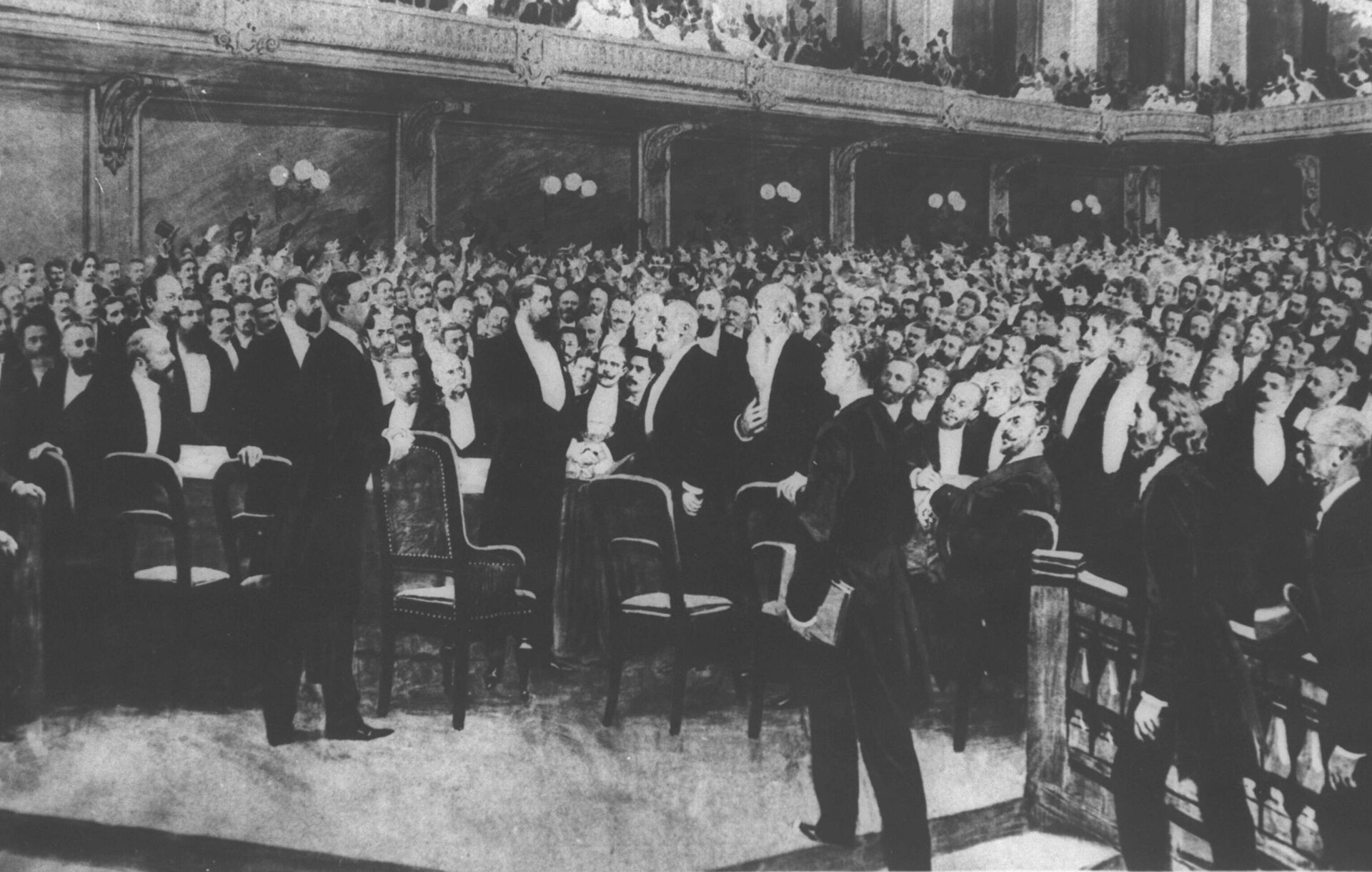 The delegates at the First Zionist Congress, held in Basel, Switzerland (1897) Pre-state institutions Zionist Organization (ZO), est. 1897 Zionist Congress (est. 1897), the supreme organ of the ZO Palestine Office (est. 1908), the executive arm of the ZO in Palestine Jewish National Fund (JNF), est. 1901 to buy and develop land in Palestine Keren Hayesod, est. 1920 to collect funds Jewish Agency, est. 1929 as the worldwide operative branch of the ZO Funding The Zionist enterprise was mainly funded by major benefactors who made large contributions, sympathisers from Jewish communities across the world (see for instance the Jewish National Fund's collection boxes), and the settlers themselves. The movement established a bank for administering its finances, the Jewish Colonial Trust (est. 1888, incorporated in London in 1899). A local subsidiary was formed in 1902 in Palestine, the Anglo-Palestine Bank. A list of pre-state large contributors to Pre-Zionist and Zionist enterprises would include, alphabetically, Isaac Leib Goldberg (1860–1935), Zionist leader and philanthropist from Russia Maurice de Hirsch (1831–1896), German Jewish financier and philanthropist, founder of the Jewish Colonization Association Moses Montefiore (1784–1885), British Jewish banker and philanthropist in Britain and the Levant, initiator and financier of Proto-Zionism Edmond James de Rothschild (1845–1934), French Jewish banker and major donor of the Zionist project Pre-state self-defense A list of Jewish pre-state self-defense organisations in Palestine would include Bar-Giora (organization) (1907–1909) HaMagen, "The Shield" (1915–17)[116] HaNoter, "The Guard" (pre-WWI, distinct from the British Madate-period Notrim)[116] Hashomer (1909–1920) Haganah (1920–1948) Palmach (1941–1948) Territories considered Main articles: Jewish territorialism and Proposals for a Jewish state Throughout the first decade of the Zionist movement, there were several instances where some Zionist figures supported a Jewish state in places outside Palestine, such as Uganda and Argentina.[117] Theodor Herzl, the founder of political Zionism was initially content with any Jewish self-governed state.[118] Jewish settlement of Argentina was the project of Maurice de Hirsch.[119] It is unclear if Herzl seriously considered this alternative plan,[120] however he later reaffirmed that Palestine would have greater attraction because of the historic ties of Jews with that area.[44] A major concern in considering other territories was the Russian pogroms, in particular the Kishinev massacre, and the resultant need for quick resettlement.[121] However, other Zionists emphasized the memory, emotion and tradition linking Jews to the Land of Israel.[122] Zion became the name of the movement, after the place where King David established his kingdom, following his conquest of the Jebusite fortress there (II Samuel 5:7, I Kings 8:1). The name Zion was synonymous with Jerusalem. Palestine only became Herzl's main focus after his Zionist manifesto 'Der Judenstaat' was published in 1896, but even then he was hesitant to focus efforts solely on resettlement in Palestine when speed was of the essence.[123] In 1903, British Colonial Secretary Joseph Chamberlain offered Herzl 5,000 square miles (13,000 km2) in the Uganda Protectorate for Jewish settlement in Great Britain's East African colonies.[124] Herzl accepted to evaluate Joseph Chamberlain's proposal,[125]: 55–56 and it was introduced the same year to the World Zionist Organization's Congress at its sixth meeting, where a fierce debate ensued. Some groups felt that accepting the scheme would make it more difficult to establish a Jewish state in Palestine, the African land was described as an "ante-chamber to the Holy Land". It was decided to send a commission to investigate the proposed land by 295 to 177 votes, with 132 abstaining. The following year, Congress sent a delegation to inspect the plateau. A temperate climate due to its high elevation, was thought to be suitable for European settlement. However, the area was populated by a large number of Maasai, who did not seem to favour an influx of Europeans. Furthermore, the delegation found it to be filled with lions and other animals. After Herzl died in 1904, the Congress decided on the fourth day of its seventh session in July 1905 to decline the British offer and, according to Adam Rovner, "direct all future settlement efforts solely to Palestine".[124][126] Israel Zangwill's Jewish Territorialist Organization aimed for a Jewish state anywhere, having been established in 1903 in response to the Uganda Scheme. It was supported by a number of the Congress's delegates. Following the vote, which had been proposed by Max Nordau, Zangwill charged Nordau that he "will be charged before the bar of history," and his supporters blamed the Russian voting bloc of Menachem Ussishkin for the outcome of the vote.[126] The subsequent departure of the JTO from the Zionist Organization had little impact.[124][127][128] The Zionist Socialist Workers Party was also an organization that favored the idea of a Jewish territorial autonomy outside of Palestine.[129] As an alternative to Zionism, Soviet authorities established a Jewish Autonomous Oblast in 1934, which remains extant as the only autonomous oblast of Russia.[130] According to Elaine Hagopian, in the early decades it foresaw the homeland of the Jews as extending not only over the region of Palestine, but into Lebanon, Syria, Jordan, and Egypt, with its borders more or less coinciding with the major riverine and water-rich areas of the Levant.[131] |
歴史的・宗教的背景 主な記事 ユダヤ人の歴史、イスラエルの歴史、パレスチナの歴史、イスラエルの地におけるユダヤ人とユダヤ教の歴史 ユダヤ人は、鉄器時代に南レバントで誕生した2つのイスラエル王国である歴史的イスラエルとユダのイスラエル人[68][69][70]とヘブライ人 [71][72]を起源とする民族宗教集団であり国家[66][67]である。ユダ王国は紀元前586年に新バビロニア帝国のネブカドネザル2世によって 征服された[77]。その後、ユダヤ人はバビロンに追放され、最初のユダヤ人ディアスポラとみなされた。 「ヒゼキヤ......ユダの王」-エルサレムで発掘された古ヘブライ文字で書かれた王家の印章 70年後、ペルシャのアケメネス朝がバビロンを征服した後、キュロス大帝はユダヤ人がエルサレムに戻り、神殿を再建することを許可した。この出来事は、シ オンへの帰還として知られるようになった。ペルシャの支配下、ユダはユダヤ人の自治州となった。数世紀にわたるペルシャとヘレニズムの支配の後、ユダヤ人 はセレウコス帝国に対するマカベアの反乱で独立を回復し、ユダヤにハスモニア王国を建国した。ハスモネア王国は紀元前63年にローマ共和国の属国となり、 紀元6年にはユダ属州としてローマ帝国に編入された[81]。 ユダヤ人の大反乱(紀元66年~73年)により、ローマ帝国はエルサレムを破壊し、第二神殿を焼き払った[82]。 エルサレムにいた60万人(タキトゥス)または100万人(ヨセフス)のユダヤ人のうち、全員が餓死するか、殺されるか、奴隷として売られた[83]。 バル・コクバの反乱(紀元132年~136年)により、ユダヤの大部分が破壊され、多くのユダヤ人が殺されるか、追放されるか、奴隷として売られた。ユダ ヤの州はシリア・パレスチナと改名された。これらの行動は、多くの学者によって、ユダヤ民族を祖国から切り離そうとする試みとみなされている[84] [85]。その後の数世紀、多くのユダヤ人がディアスポラの繁栄する中心地に移住した。また、ガリラヤ、海岸平野、ユダヤの端に住み続け、改宗する者もい た。 紀元4世紀までに、それまでパレスチナの大多数を占めていたユダヤ人は少数派となった。例えば、伝承によれば、ペキインのユダヤ人コミュニティは第二神殿 時代からユダヤ人の存在を維持していた[89][90]。 バル・コクバの反乱(132-135CE)のコイン。表は「エルサレムの自由へ」に囲まれたラッパ。裏面は "イスラエルの自由への2年目 "に囲まれた竪琴。 ユダヤ教の宗教的信条では、イスラエルの地は、トーラー、特に創世記と出エジプト記、そして後の預言書に基づいて、イスラエルの子らが神から授かった遺産 であるとされている[91][92][93]。 [91][92][93]創世記によれば、カナンはまずアブラハムの子孫に約束された。このテキストは、これがアブラハムの子孫に対する神とアブラハムの 契約であることを明示している[94]。神が約束の地としてカナンをイスラエルの民に割り当てたという信仰は、キリスト教[95]やイスラム教の伝統にも 保存されている[96]。 ディアスポラのユダヤ人の間では、イスラエルの地は文化的、国家的、民族的、歴史的、宗教的な意味で崇められていた。特に過越の祭りとヨム・キプールの祈 りでは、伝統的に「来年はエルサレムで」で締めくくられ、1日3回のアミダー(立礼の祈り)においても、シオンへの帰還が世代を超えて繰り返しテーマとし て扱われた[97]。 [98]キブツ・ガルヨットの聖書の預言、すなわち預言者たちによって予告されたイスラエルの地への亡命者の集結は、シオニズムの中心的な思想となった [99][100][101]。 シオニズム以前の取り組み 北イスラエルのサフェドにセファルディ派のユダヤ人によって設立された15世紀のアブハブ・シナゴーグ[102][要出典]。 16世紀半ば、ポルトガルのセファルディであるジョセフ・ナシは、オスマン帝国の支援を受けて、ポルトガルのユダヤ人を集め、最初は当時ヴェネツィア共和 国が所有していたキプロスに移住させ、後にティベリアに再定住させようとした。ナシはイスラームに改宗することなく[103][104]、やがてオスマン 帝国で最高の医学職に就き、宮廷生活にも積極的に参加した。彼はスレイマン1世に、アンコーナに幽閉されたオスマン・トルコの被支配者であるポルトガル系 ユダヤ人に代わってローマ教皇に介入するよう説得した[103]。4世紀から19世紀にかけて、ナシはパレスチナにある種のユダヤ人の政治的中心を確立し ようとした唯一の実際的な試みであった[105][要出典]。 17世紀、サッバタイ・ゼヴィ(Sabbatai Zevi, 1626-1676)は自らを救世主と名乗り、多くのユダヤ人を味方につけ、サロニカに拠点を形成した。彼は最初ガザに集落を作ろうとしたが、後にスミル ナに移った。1666年春、老ラビ、アーロン・ラパパを追放した後、フランス、アヴィニョンのユダヤ人社会は新王国への移住を準備した。当時のユダヤ人が サバタイ・ゼヴィのメシア的主張を信じようとしたのは、17世紀半ばの中央ヨーロッパのユダヤ人の絶望的な状況によるところが大きいかもしれない。ボフダ ン・フメルニツキーの血なまぐさいポグロムによってユダヤ人人口の3分の1が一掃され、ユダヤ人の学問と共同生活の中心地の多くが破壊された[106]。 19世紀初頭、ペルシムとして知られるユダヤ人の一団がリトアニアを離れ、オスマン・パレスチナに定住した。 シオニスト運動の確立 19世紀、シオンへの帰還を支持するユダヤ教の潮流が、特にユダヤ人に対する反ユダヤ主義や敵意が高まっていたヨーロッパで人気を博した[107]。パレ スチナへの帰還という考えは、その時代に開催されたラビの会議では否定された。実質的なシオニズムの始まりとされる1897年の第1回シオニスト会議以前 にも、シオニスト以前のアリアと呼ばれるパレスチナへのユダヤ人集団の移住は個人の努力によって支持されていた[108]。 改革派のユダヤ人たちはこのシオンへの帰還という考えを否定した。1845年7月15日から28日にかけてフランクフルト・アム・マインで開催されたラビ 会議では、シオンへの帰還とユダヤ人国家の回復を願う祈りが儀式からすべて削除された。1869年のフィラデルフィア会議では、ドイツのラビたちに倣い、 イスラエルのメシア的希望は「神の一致を告白するすべての神の子たちの結合」であるとされた。1885年、ピッツバーグ会議は、改革派ユダヤ教のメシア的 思想のこの解釈を繰り返し、「われわれはもはや自らを国家ではなく、宗教的共同体であると考える。したがって、われわれはパレスチナへの帰還も、アロンの 息子たちの下での犠牲祭も、ユダヤ国家に関するいかなる法律の回復も期待しない」と決議で表明した[109]。  1841年、『コロニアル・タイムズ』紙に掲載された「ユダヤ人のパレスチナ復帰のためのヨーロッパのプロテスタント君主への覚書」。 1819年、W.D.ロビンソンによってミシシッピ州上部にユダヤ人入植地が提案され[110]、1850年にはユダヤ教に改宗したアメリカ領事ウォー ダー・クレッソンによってエルサレム近郊に他の入植地が開発された。クレッソンは妻と息子によって起こされた訴訟で精神異常者として裁かれ、断罪された。 彼らは、キリスト教からユダヤ教に改宗するのは精神異常者だけだと主張した。アメリカの「信仰の自由」の問題と反ユダヤ主義の中心性に基づいて行われた二 審の結果、クレッソンは激しい争いの末に勝訴した[111]。彼はオスマン・パレスチナに移住し、エルサレムのレフィームの谷に農業コロニーを設立した。 彼は「私たちの貧しい同胞の窮乏を利用しようとするいかなる試みも......(それは)......阻止する」ことを望んだ。強制的に見せかけの改宗を させる」[112][better source needed]。 プラハでは、1835年にアブラハム・ベニッシュとモーリッツ・シュタインシュナイダーによって、ユダヤ人移民を組織するための道徳的な努力はなされた が、実際的な努力はなされなかった。アメリカでは、モルデカイ・ノアが1825年、ニューヨーク州バッファロー向かいのグランド・アイルにユダヤ人避難所 を設立しようとした。これらクレッソン、ベニッシュ、シュタインシュナイダー、ノアの初期のユダヤ人国家建設の努力は失敗に終わった[113][要ペー ジ][114]。 モンテフィオーレ卿は、エドガルド・モルタラ救出の試みなど、世界中のユダヤ人のために介入したことで有名であり、パレスチナにユダヤ人のためのコロニー を設立した。1854年、彼の友人であったユダ・トゥーロは、パレスチナにおけるユダヤ人居住区の設立資金を遺贈した。モンテフィオーレは彼の遺言執行者 に任命され、1860年にエルサレムの城壁に囲まれた旧市街の外に、現在ミシュケノト・シャアナニムとして知られる最初のユダヤ人居住区と施し所を建設す るなど、さまざまなプロジェクトに資金を使った。ローレンス・オリファントは、ポーランド、リトアニア、ルーマニア、トルコ帝国のユダヤ人プロレタリアー トをパレスチナに呼び寄せようとしたが失敗した(1879年と1882年)。 パレスチナにおける新イシュヴの建設が正式に始まったのは、通常、1882年にビリュ一派が到着し、第一次アリヤを開始したときとされている。その後、パ レスチナへのユダヤ人移民が本格的に始まった。移民の多くはロシア帝国からで、現在のウクライナやポーランドで頻発したポグロムや国家主導の迫害から逃れ てきた。彼らは西ヨーロッパのユダヤ人篤志家からの資金援助を受けて、多くの農業入植地を設立した。19世紀末、パレスチナではユダヤ人は少数派となっ た。 リション・レジオンの大シナゴーグは1885年に設立された。 1890年代には、テオドール・ヘルツル(政治的シオニズムの父)がシオニズムに新たなイデオロギーと現実的な緊急性を吹き込み、1897年にバーゼルで 第1回シオニスト会議が開催され、シオニスト機構(ZO)が創設され、1960年に世界シオニスト機構(WZO)と改称された[115]。  1896年1月17日、『ユダヤ人クロニクル』誌の一面。テオドール・ヘルツルのパンフレット『Der Judenstaat』が出版される1ヶ月前の記事。  スイスのバーゼルで開催された第1回シオニスト会議の代表団(1897年) 国家以前の組織 シオニスト機構(ZO)、設立。1897 シオニスト会議(1897年)、ZOの最高機関 パレスチナ事務所(1908年設立):パレスチナにおけるZOの執行機関 ユダヤ民族基金(JNF)。1901年設立。パレスチナの土地を購入し開発する。 ケレン・ヘイソド(Keren Hayesod):1920年設立。1920年に設立され、資金を集める ユダヤ人庁(Jewish Agency)設立。1929年、ZOの世界的な活動支部として設立。 資金調達 シオニスト事業の資金は、主に多額の寄付をした大口の篤志家、世界中のユダヤ人社会からの共感者(例えばユダヤ民族基金の募金箱など)、そして入植者自身 によって賄われた。運動は、その財政を管理するための銀行、ユダヤ植民地信託(1888年設立、1899年にロンドンで法人化)を設立した。1902年に はパレスチナの現地法人、アングロ・パレスチナ銀行が設立された。 プレ・シオニストおよびシオニスト事業への国家以前の大口献金者のリストは、アルファベット順に以下の通りである、 アイザック・リーブ・ゴールドバーグ(1860-1935)、ロシア出身のシオニスト指導者、慈善家 モーリス・ド・ヒルシュ(1831-1896)、ドイツのユダヤ人金融家、慈善家、ユダヤ人植民地化協会の創設者 モーゼス・モンテフィオーレ(1784~1885):イギリスとレバントのユダヤ人銀行家・慈善家、原シオニズムの創始者・資金提供者 エドモンド・ジェイムズ・ド・ロスチャイルド(1845-1934)、フランスのユダヤ人銀行家、シオニズム計画の主要な資金提供者 国家以前の自衛 パレスチナにおけるユダヤ人の国家前自衛組織のリストを以下に挙げる。 バルギオラ(組織)(1907年-1909年) ハマーゲン、「盾」(1915-17年)[116]。 ハノター、「衛兵」(第一次世界大戦前、イギリス狂犬病時代のノトリムとは異なる)[116]。 ハショメル(1909年-1920年) ハガナー(1920年-1948年) パルマハ(1941年-1948年) 考慮された領土 主な記事 ユダヤ領土主義とユダヤ国家の提案 シオニズム運動の最初の10年間を通じて、シオニストの中にはウガンダやアルゼンチンなど、パレスチナ以外の場所でのユダヤ人国家を支持する人物もいた [117]。 [118]アルゼンチンへのユダヤ人入植はモーリス・ド・ヒルシュのプロジェクトであった[119]。ヘルツルがこの代替案を真剣に検討したかどうかは定 かではないが[120]、しかし彼は後にパレスチナとその地域とのユダヤ人の歴史的な結びつきから、パレスチナがより大きな魅力を持つだろうと再確認して いる[44]。 しかし、他のシオニストたちは、ユダヤ人とイスラエルの地を結びつける記憶、感情、伝統を強調した[122]。シオンは、ダビデ王がエブス人の要塞を征服 した後、王国を築いた場所(Ⅱサムエル記5:7、Ⅰ列王記8:1)にちなんで、運動の名称となった。シオンはエルサレムと同義語であった。パレスチナがヘ ルツルの主要な焦点となったのは、1896年にシオニスト宣言『ユダヤ人居住地(Der Judenstaat)』が出版されてからのことであったが、その時でさえ、彼は、スピードが重要であるにもかかわらず、パレスチナへの再定住のみに力を 注ぐことを躊躇していた[123]。 1903年、イギリスの植民地長官ジョセフ・チェンバレンは、イギリスの東アフリカ植民地におけるユダヤ人入植のために、ウガンダ保護領の5,000平方 マイル(13,000 km2)をヘルツルに提供した[124]: 同年、世界シオニスト機構(World Zionist Organization)の第6回会議において、この案は紹介され、激しい議論が繰り広げられた。一部のグループは、この計画を受け入れるとパレスチナ にユダヤ人国家を樹立することが難しくなると感じ、アフリカの土地は「聖地の前室」と表現された。提案された土地を調査する委員会を派遣することは、 295対177票(132人が棄権)で決定された。翌年、議会は視察団を派遣した。標高が高いため温暖な気候で、ヨーロッパ人の入植に適していると考えら れていた。しかし、この地域には多くのマサイ族が住んでおり、彼らはヨーロッパ人の流入を好まないようだった。さらに使節団は、ライオンやその他の動物が たくさんいることを発見した。 1904年にヘルツルが死去した後、大会は1905年7月の第7回会議の4日目に、イギリスの申し出を辞退することを決定し、アダム・ロヴナーによれば、 「将来的な入植の努力はすべてパレスチナだけに向ける」ことにした[124][126]。この組織は大会の多くの代議員によって支持された。マックス・ノ ルダウによって提案された投票の後、ザングウィルはノルダウを「歴史の法廷の前で告発されるだろう」と非難し、彼の支持者たちは投票の結果についてメナケ ム・ウシシキンのロシア人投票団を非難した[126]。 その後のシオニスト組織からのJTOの離脱は、ほとんど影響を与えなかった[124][127][128]。シオニスト社会主義労働者党もまた、パレスチ ナ以外のユダヤ人の領土自治の考えを支持する組織であった[129]。 シオニズムに代わるものとして、ソ連当局は1934年にユダヤ人自治州を設立し、これはロシア唯一の自治州として存続している[130]。 エレイン・ハゴピアンによれば、初期の数十年間はユダヤ人の祖国がパレスチナの地域だけでなく、レバノン、シリア、ヨルダン、エジプトにまで及ぶことを予 見しており、その国境はレバントの主要な河川地帯や水の豊富な地域と多かれ少なかれ一致していた[131]。 |
| Balfour Declaration and the
Mandate for Palestine Main articles: Balfour Declaration and Mandate for Palestine 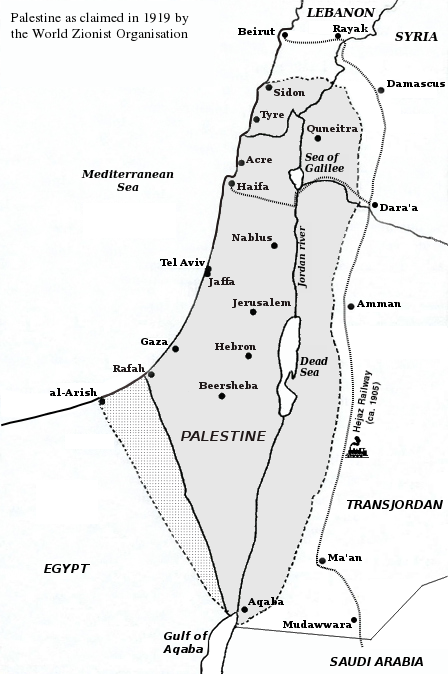 Palestine as claimed by the World Zionist Organization in 1919 at the Paris Peace Conference Lobbying by Russian Jewish immigrant Chaim Weizmann, together with fear that American Jews would encourage the US to support Germany in the war against Russia, culminated in the British government's Balfour Declaration of 1917. It endorsed the creation of a Jewish homeland in Palestine, as follows: His Majesty's government view with favour the establishment in Palestine of a national home for the Jewish people, and will use their best endeavours to facilitate the achievement of this object, it being clearly understood that nothing shall be done which may prejudice the civil and religious rights of existing non-Jewish communities in Palestine, or the rights and political status enjoyed by Jews in any other country.[132] 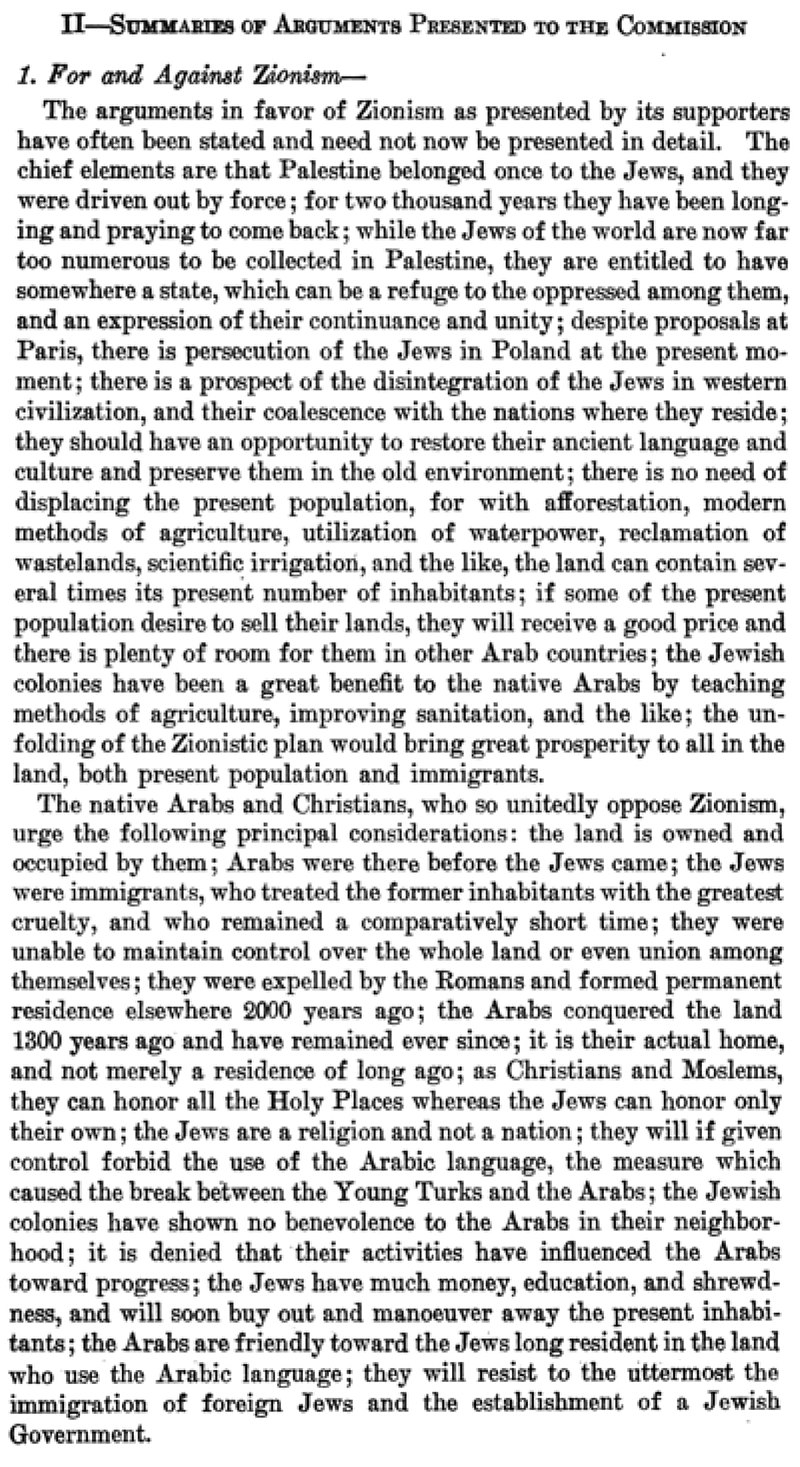 During the 1919 Paris Peace Conference, an Inter-Allied Commission was sent to Palestine to assess the views of the local population; the report summarized the arguments received from petitioners for and against Zionism. In 1922, the League of Nations adopted the declaration, and granted to Britain the Palestine Mandate: The Mandate will secure the establishment of the Jewish national home ... and the development of self-governing institutions, and also safeguard the civil and religious rights of all the inhabitants of Palestine, irrespective of race and religion.[133] Weizmann's role in obtaining the Balfour Declaration led to his election as the Zionist movement's leader. He remained in that role until 1948, and then was elected as the first President of Israel after the nation gained independence. A number of high-level representatives of the international Jewish women's community participated in the First World Congress of Jewish Women, which was held in Vienna, Austria, in May 1923. One of the main resolutions was: "It appears ... to be the duty of all Jews to co-operate in the social-economic reconstruction of Palestine and to assist in the settlement of Jews in that country."[134] In 1927, Ukrainian Jew Yitzhak Lamdan wrote an epic poem titled Masada to reflect the plight of the Jews, calling for a "last stand".[135] Rise of Nazism and the Holocaust In 1933, Hitler came to power in Germany, and in 1935 the Nuremberg Laws made German Jews (and later Austrian and Czech Jews) stateless refugees. Similar rules were applied by the many Nazi allies in Europe. The subsequent growth in Jewish migration and the impact of Nazi propaganda aimed at the Arab world fostered the 1936–1939 Arab revolt in Palestine. Britain established the Peel Commission to investigate the situation. The commission called for a two-state solution and compulsory transfer of populations. The Arabs opposed the partition plan and Britain later rejected this solution and instead implemented the White Paper of 1939. This planned to end Jewish immigration by 1944 and to allow no more than 75,000 additional Jewish migrants. At the end of the five-year period in 1944, only 51,000 of the 75,000 immigration certificates provided for had been utilized, and the British offered to allow immigration to continue beyond cutoff date of 1944, at a rate of 1500 per month, until the remaining quota was filled.[136][137] According to Arieh Kochavi, at the end of the war, the Mandatory Government had 10,938 certificates remaining and gives more details about government policy at the time.[136] The British maintained the policies of the 1939 White Paper until the end of the Mandate.[138] 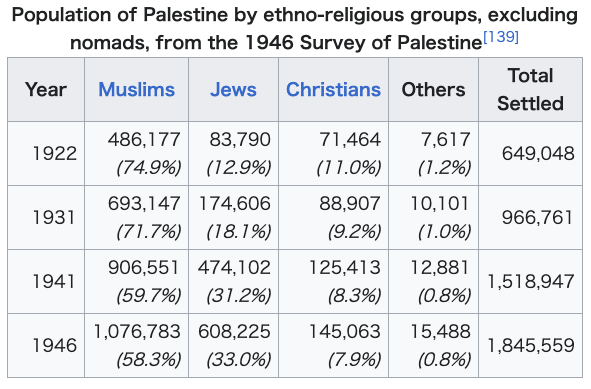 The growth of the Jewish community in Palestine and the devastation of European Jewish life sidelined the World Zionist Organization. The Jewish Agency for Palestine under the leadership of David Ben-Gurion increasingly dictated policy with support from American Zionists who provided funding and influence in Washington, D.C., including via the highly effective American Palestine Committee.[citation needed] 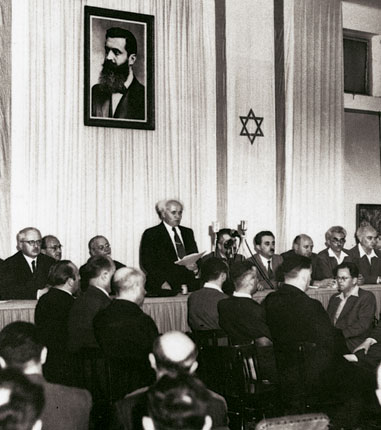 David Ben-Gurion proclaiming Israel's independence beneath a large portrait of Theodor Herzl During World War II, as the horrors of the Holocaust became known, the Zionist leadership formulated the One Million Plan, a reduction from Ben-Gurion's previous target of two million immigrants. Following the end of the war, many stateless refugees, mainly Holocaust survivors, began migrating to Palestine in small boats in defiance of British rules. The Holocaust united much of the rest of world Jewry behind the Zionist project.[140] The British either imprisoned these Jews in Cyprus or sent them to the British-controlled Allied Occupation Zones in Germany. The British, having faced Arab revolts, were now facing opposition by Zionist groups in Palestine for subsequent restrictions on Jewish immigration. In January 1946 the Anglo-American Committee of Inquiry, a joint British and American committee, was tasked to examine political, economic and social conditions in Mandatory Palestine and the well-being of the peoples now living there; to consult representatives of Arabs and Jews, and to make other recommendations 'as necessary' for an interim handling of these problems as well as for their eventual solution.[141] Following the failure of the 1946–47 London Conference on Palestine, at which the United States refused to support the British leading to both the Morrison–Grady Plan and the Bevin Plan being rejected by all parties, the British decided to refer the question to the UN on February 14, 1947.[142][fn 2] Post-World War II Arab offensive at the beginning of the 1948 Arab-Israeli war With the German invasion of the USSR in 1941, Stalin reversed his long-standing opposition to Zionism, and tried to mobilize worldwide Jewish support for the Soviet war effort. A Jewish Anti-Fascist Committee was set up in Moscow. Many thousands of Jewish refugees fled the Nazis and entered the Soviet Union during the war, where they reinvigorated Jewish religious activities and opened new synagogues.[143] In May 1947 Soviet Deputy Foreign Minister Andrei Gromyko told the United Nations that the USSR supported the partition of Palestine into a Jewish and an Arab state. The USSR formally voted that way in the UN in November 1947.[144] However once Israel was established, Stalin reversed positions, favoured the Arabs, arrested the leaders of the Jewish Anti-Fascist Committee, and launched attacks on Jews in the USSR.[145] In 1947, the United Nations Special Committee on Palestine recommended that western Palestine should be partitioned into a Jewish state, an Arab state and a UN-controlled territory, Corpus separatum, around Jerusalem.[146] This partition plan was adopted on November 29, 1947, with UN GA Resolution 181, 33 votes in favor, 13 against, and 10 abstentions. The vote led to celebrations in Jewish communities and protests in Arab communities throughout Palestine.[citation needed] Violence throughout the country, previously an Arab and Jewish insurgency against the British, Jewish-Arab communal violence, spiralled into the 1947–1949 Palestine war. The conflict led to an exodus of about 711,000 Palestinian Arabs,[147] outside of Israel's territories. More than a quarter had already fled prior to the Israeli Declaration of Independence and the start of the war. After the 1949 Armistice Agreements, a series of laws passed by the first Israeli government prevented displaced Palestinians from claiming private property or returning on the state's territories. They and many of their descendants remain refugees supported by UNRWA.[148][149] 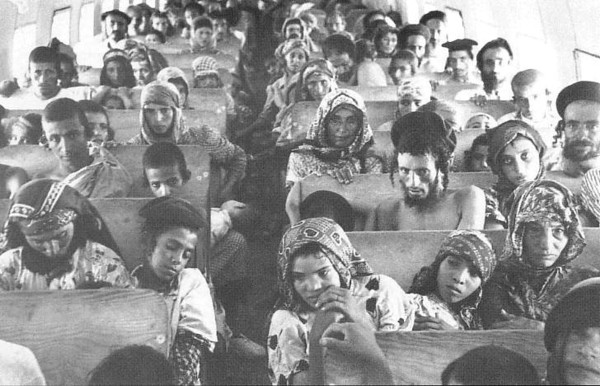 Yemenite Jews on their way to Israel during Operation Magic Carpet (1949-1950) Since the creation of the State of Israel, the World Zionist Organization has functioned mainly as an organization dedicated to assisting and encouraging Jews to migrate to Israel. It has provided political support for Israel in other countries but plays little role in internal Israeli politics. The movement's major success since 1948 was in providing logistical support for Jewish migrants and refugees and, most importantly, in assisting Soviet Jews in their struggle with the authorities over the right to leave the USSR and to practice their religion in freedom, and the exodus of 850,000 Jews from the Arab world, mostly to Israel. In 1944–45, Ben-Gurion described the One Million Plan to foreign officials as being the "primary goal and top priority of the Zionist movement."[150] The immigration restrictions of the British White Paper of 1939 meant that such a plan could not be put into large scale effect until the Israeli Declaration of Independence in May 1948. The new country's immigration policy had some opposition within the new Israeli government, such as those who argued that there was "no justification for organizing large-scale emigration among Jews whose lives were not in danger, particularly when the desire and motivation were not their own"[151] as well as those who argued that the absorption process caused "undue hardship".[152] However, the force of Ben-Gurion's influence and insistence ensured that his immigration policy was carried out.[153][154] |
バルフォア宣言とパレスチナ委任統治 主な記事 バルフォア宣言とパレスチナ委任統治  1919年のパリ講和会議で世界シオニスト機構が主張したパレスチナ ロシア系ユダヤ人移民のチャイム・ワイツマンによる働きかけは、アメリカのユダヤ人が対ロシア戦争でドイツを支持するようアメリカに働きかけるのではない かという懸念とともに、1917年のイギリス政府によるバルフォア宣言に結実した。 同宣言は、パレスチナにユダヤ人の祖国を建設することを次のように支持した: 陛下の政府は、パレスチナにユダヤ民族のための民族の故郷を建設することを好意的に受け止めており、この目的の達成を促進するために最善の努力を払うが、 パレスチナに存在するユダヤ人以外の共同体の市民的・宗教的権利、あるいは他のいかなる国においてもユダヤ人が享受している権利や政治的地位を損なうよう なことがあってはならないことは明確に理解されている[132]。  1919年のパリ講和会議では、地元住民の意見を評価するために連合国間委員会がパレスチナに派遣され、報告書はシオニズムに賛成する請願者と反対する請 願者から受け取った議論を要約した。 1922年、国際連盟はこの宣言を採択し、イギリスにパレスチナ委任統治権を与えた: 委任統治は、ユダヤ人の民族的故郷の確立と......自治制度の発展を確保し、人種や宗教に関係なくパレスチナの全住民の市民的・宗教的権利を保護する ものである[133]。 ワイツマンは、バルフォア宣言を得るために果たした役割により、シオニスト運動の指導者に選出された。ワイツマンは1948年までその役割を果たし、イス ラエル独立後は初代大統領に選出された。 1923年5月にオーストリアのウィーンで開催された第1回ユダヤ人女性世界会議には、国際的なユダヤ人女性コミュニティの高位代表が多数参加した。主な 決議のひとつは次のようなものだった: 「パレスチナの社会経済的再建に協力し、同国へのユダヤ人の定住を援助することは、すべてのユダヤ人の義務である」[134]。 1927年、ウクライナ系ユダヤ人のイツァーク・ラムダンは、ユダヤ人の窮状を反映した『マサダ』というタイトルの叙事詩を書き、「最後の抵抗」を呼びか けた[135]。 ナチズムの台頭とホロコースト 1933年、ヒトラーがドイツで政権を握り、1935年にはニュルンベルク法でドイツのユダヤ人(後にオーストリアやチェコのユダヤ人も)が無国籍の難民 とされた。同様の規則は、ヨーロッパの多くのナチス同盟国にも適用された。その後、ユダヤ人の移住が増加し、アラブ世界を狙ったナチスのプロパガンダの影 響で、1936年から1939年にかけてパレスチナでアラブの反乱が起こった。イギリスはこの状況を調査するため、ピール委員会を設立した。同委員会は、 2国家による解決と人口の強制移住を求めた。アラブ人は分割計画に反対し、イギリスは後にこの解決策を拒否し、代わりに1939年の白書を実施した。この 白書は、1944年までにユダヤ人移民を終了させ、75,000人以上のユダヤ人移民を追加で認めないというものであった。1944年の5年間が終わった 時点で、用意された75,000人の移民証明書のうち51,000人しか利用されておらず、イギリスは残りの枠が埋まるまで、月1,500人の割合で 1944年の締切日を超えて移民を続けることを許可することを申し出た[136][137]。 アリエ・コチャヴィによると、終戦時、委任統治政府には10,938人の証明書が残っており、当時の政府の政策についてより詳しく述べている[136]。 イギリスは委任統治が終わるまで、1939年の白書の政策を維持した[138]。  パレスチナにおけるユダヤ人社会の発展とヨーロッパのユダヤ人生活の荒廃は、世界シオニスト機構を傍観させた。ダヴィド・ベングリオン率いるユダヤ人パレ スチナ機関は、非常に効果的なアメリカン・パレスチナ委員会(American Palestine Committee)などを通じ、ワシントンD.C.で資金と影響力を提供したアメリカ人シオニストの支援を受け、ますます政策に口を出すようになった [要出典]。  テオドール・ヘルツルの大きな肖像画の下でイスラエルの独立を宣言するダヴィド・ベングリオン 第二次世界大戦中、ホロコーストの惨状が知られるようになると、シオニスト指導部は100万人計画を策定した。終戦後、ホロコーストの生存者を中心とする 多くの無国籍難民が、英国の規則に背いて小舟でパレスチナへの移住を開始した。ホロコーストは世界のユダヤ人の多くをシオニスト・プロジェクトの背後に団 結させた[140]。イギリスはこれらのユダヤ人をキプロスに幽閉するか、イギリスが支配するドイツの連合国占領区に送った。アラブの反乱に直面したイギ リスは、今度はパレスチナでシオニスト・グループによるユダヤ人移民の制限に対する反対に直面した。1946年1月、英米合同調査委員会(Anglo- American Committee of Inquiry)は、委任統治領パレスチナの政治的、経済的、社会的状況とそこに住む人々の幸福を調査し、アラブ人とユダヤ人の代表と協議し、これらの問 題の暫定的な処理と最終的な解決のために「必要に応じて」その他の勧告を行うよう命じられた。 [141]1946年から47年にかけてのロンドン・パレスチナ会議が失敗し、アメリカがイギリスへの支持を拒否したためにモリソン・グラディ・プランと ベヴィン・プランの両方が全当事者によって拒否されたことを受けて、イギリスは1947年2月14日にこの問題を国連に付託することを決定した[142] [fn 2]。 第二次世界大戦後 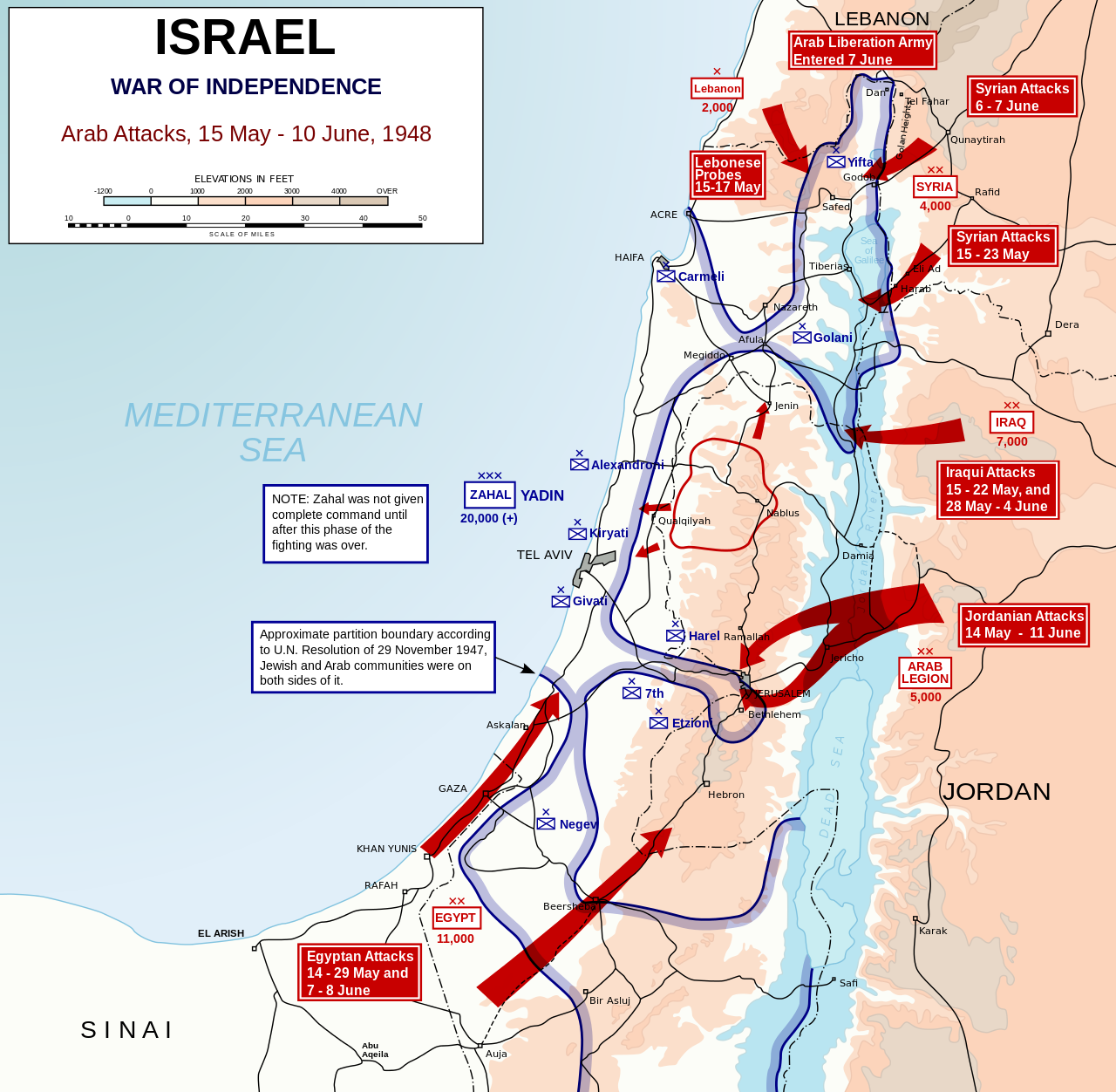 1948年アラブ・イスラエル戦争開戦時のアラブの攻勢 1941年にドイツがソ連に侵攻すると、スターリンは長年のシオニズムへの反対を撤回し、ソ連の戦争努力に世界中のユダヤ人の支援を動員しようとした。ユ ダヤ人反ファシスト委員会がモスクワに設立された。1947年5月、ソ連のアンドレイ・グロムイコ外務副大臣は国連で、ソ連はパレスチナをユダヤ国家とア ラブ国家に分割することを支持すると述べた。しかし、イスラエルが建国されると、スターリンは立場を逆転させ、アラブ人を支持し、ユダヤ人反ファシスト委 員会の指導者を逮捕し、ソ連国内のユダヤ人に対する攻撃を開始した[145]。 1947年、国連パレスチナ特別委員会は、パレスチナ西部をユダヤ人国家、アラブ人国家、そしてエルサレム周辺の国連管理領域である分離統治領に分割する ことを勧告した[146]。この分割案は1947年11月29日、国連総会決議181号によって賛成33票、反対13票、棄権10票で採択された。 1947年11月29日、国連総会決議181号が採択され、賛成33票、反対13票、棄権10票で、パレスチナ全土のユダヤ人社会では祝賀の声が上がり、 アラブ人社会では抗議の声が上がった。この紛争により、約71万1000人のパレスチナ・アラブ人がイスラエル領外に脱出した[147]。その4分の1以 上は、イスラエルの独立宣言と戦争が始まる前にすでに国外に逃れていた。1949年の休戦協定後、第一次イスラエル政府によって可決された一連の法律は、 避難したパレスチナ人が私有財産を主張したり、国家の領土に戻ることを妨げた。彼らとその子孫の多くはUNRWAによって支援される難民のままである [148][149]。  マジックカーペット作戦でイスラエルに向かうイエメン系ユダヤ人 イスラエル建国以来、世界シオニスト機構は主にユダヤ人のイスラエル移住を支援・奨励する組織として機能してきた。他国ではイスラエルを政治的に支援して きたが、イスラエル国内政治ではほとんど役割を果たしていない。1948年以降、この運動が大きな成功を収めたのは、ユダヤ人の移民や難民に後方支援を提 供したこと、そして最も重要なのは、ソ連からの出国と自由な宗教実践の権利をめぐる当局との闘争において、ソ連のユダヤ人を支援したことである。1944 年から45年にかけて、ベン=グリオンは100万人計画を「シオニスト運動の第一目標であり最優先事項」であると外国政府関係者に説明している [150]。1939年のイギリス白書による移民制限のため、このような計画は1948年5月のイスラエル独立宣言まで大規模に実施することができなかっ た。新生イスラエルの移民政策には、新イスラエル政府内で「命に別状がないユダヤ人の間で大規模な移住を組織する正当性はない、特にその願望と動機が彼ら 自身のものでない場合には」[151]と主張する者や、吸収プロセスが「過度の苦難」を引き起こすと主張する者など、反対意見もあった[152]。 しかしながら、ベン=グリオンの影響力と主張の強さは、彼の移民政策が実行されることを確実にした[153][154]。 |
| Types Main article: Types of Zionism 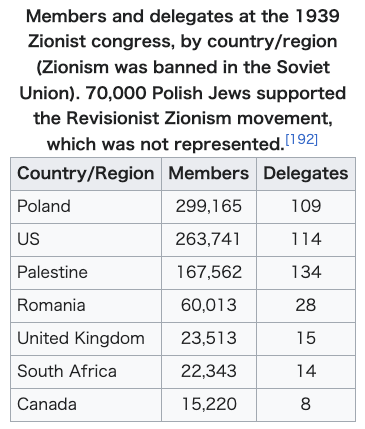 The multi-national, worldwide Zionist movement is structured on representative democratic principles. Congresses are held every four years (they were held every two years before the Second World War) and delegates to the congress are elected by the membership. Members are required to pay dues known as a shekel. At the congress, delegates elect a 30-man executive council, which in turn elects the movement's leader. The movement was democratic from its inception and women had the right to vote.[156] Until 1917, the World Zionist Organization pursued a strategy of building a Jewish National Home through persistent small-scale immigration and the founding of such bodies as the Jewish National Fund (1901 – a charity that bought land for Jewish settlement) and the Anglo-Palestine Bank (1903 – provided loans for Jewish businesses and farmers). In 1942, at the Biltmore Conference, the movement included for the first time an express objective of the establishment of a Jewish state in the Land of Israel.[157] The 28th Zionist Congress, meeting in Jerusalem in 1968, adopted the five points of the "Jerusalem Program" as the aims of Zionism today. They are:[158] Unity of the Jewish People and the centrality of Israel in Jewish life Ingathering of the Jewish People in its historic homeland, Eretz Israel, through Aliyah from all countries Strengthening of the State of Israel, based on the prophetic vision of justice and peace Preservation of the identity of the Jewish People through fostering of Jewish and Hebrew education, and of Jewish spiritual and cultural values Protection of Jewish rights everywhere Since the creation of modern Israel, the role of the movement has declined. It is now a peripheral factor in Israeli politics, though different perceptions of Zionism continue to play roles in Israeli and Jewish political discussion.[159] Labor Zionism Main article: Labor Zionism 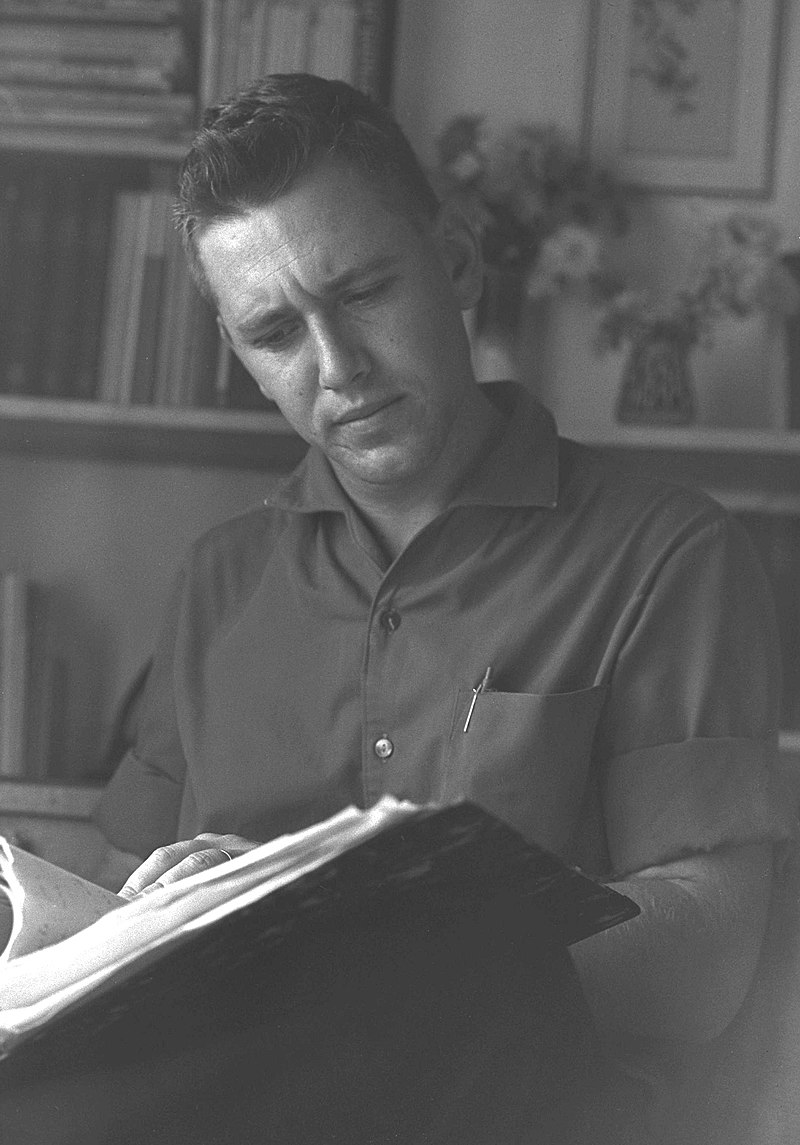 Israeli author Amos Oz, who today is described as the 'aristocrat' of Labor Zionism[160] Israeli Jewish youth from the Socialist Zionist youth movement No'al, meeting with Jewish resistance fighter Simcha Rotem. Founded in 1924, No'al is one of the largest Zionist Youth movements. Labor Zionism originated in Eastern Europe. Socialist Zionists believed that centuries of oppression in antisemitic societies had reduced Jews to a meek, vulnerable, despairing existence that invited further antisemitism, a view originally stipulated by Theodor Herzl. They argued that a revolution of the Jewish soul and society was necessary and achievable in part by Jews moving to Israel and becoming farmers, workers, and soldiers in a country of their own. Most socialist Zionists rejected the observance of traditional religious Judaism as perpetuating a "Diaspora mentality" among the Jewish people, and established rural communes in Israel called "kibbutzim". The kibbutz began as a variation on a "national farm" scheme, a form of cooperative agriculture where the Jewish National Fund hired Jewish workers under trained supervision. The kibbutzim were a symbol of the Second Aliyah in that they put great emphasis on communalism and egalitarianism, representing Utopian socialism to a certain extent. Furthermore, they stressed self-sufficiency, which became an essential aspect of Labor Zionism. Though socialist Zionism draws its inspiration and is philosophically founded on the fundamental values and spirituality of Judaism, its progressive expression of that Judaism has often fostered an antagonistic relationship with Orthodox Judaism.[citation needed] Labor Zionism became the dominant force in the political and economic life of the Yishuv during the British Mandate of Palestine and was the dominant ideology of the political establishment in Israel until the 1977 election when the Israeli Labor Party was defeated. The Israeli Labor Party continues the tradition, although the most popular party in the kibbutzim is Meretz.[161] Labor Zionism's main institution is the Histadrut (general organisation of labor unions), which began by providing strikebreakers against a Palestinian worker's strike in 1920 and until 1970s was the largest employer in Israel after the Israeli government.[162] Liberal Zionism Main article: General Zionists 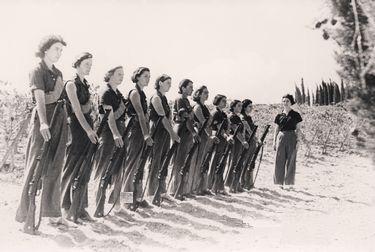 Kibbutznikiyot (female Kibbutz members) in Mishmar HaEmek, during the 1948 Arab–Israeli War. The Kibbutz is the historical heartland of Labor Zionism. General Zionism (or Liberal Zionism) was initially the dominant trend within the Zionist movement from the First Zionist Congress in 1897 until after the First World War. General Zionists identified with the liberal European middle class to which many Zionist leaders such as Herzl and Chaim Weizmann aspired. Liberal Zionism, although not associated with any single party in modern Israel, remains a strong trend in Israeli politics advocating free market principles, democracy and adherence to human rights. Their political arm was one of the ancestors of the modern-day Likud. Kadima, the main centrist party during the 2000s that split from Likud and is now defunct, however, did identify with many of the fundamental policies of Liberal Zionist ideology, advocating among other things the need for Palestinian statehood in order to form a more democratic society in Israel, affirming the free market, and calling for equal rights for Arab citizens of Israel. In 2013, Ari Shavit suggested that the success of the then-new Yesh Atid party (representing secular, middle-class interests) embodied the success of "the new General Zionists."[163][better source needed] Dror Zeigerman writes that the traditional positions of the General Zionists—"liberal positions based on social justice, on law and order, on pluralism in matters of State and Religion, and on moderation and flexibility in the domain of foreign policy and security"—are still favored by important circles and currents within certain active political parties.[164] Philosopher Carlo Strenger describes a modern-day version of Liberal Zionism (supporting his vision of "Knowledge-Nation Israel"), rooted in the original ideology of Herzl and Ahad Ha'am, that stands in contrast to both the romantic nationalism of the right and the Netzah Yisrael of the ultra-Orthodox. It is marked by a concern for democratic values and human rights, freedom to criticize government policies without accusations of disloyalty, and rejection of excessive religious influence in public life. "Liberal Zionism celebrates the most authentic traits of the Jewish tradition: the willingness for incisive debate; the contrarian spirit of davka; the refusal to bow to authoritarianism."[165][166] Liberal Zionists see that "Jewish history shows that Jews need and are entitled to a nation-state of their own. But they also think that this state must be a liberal democracy, which means that there must be strict equality before the law independent of religion, ethnicity or gender."[167] Revisionist Zionism Main article: Revisionist Zionism 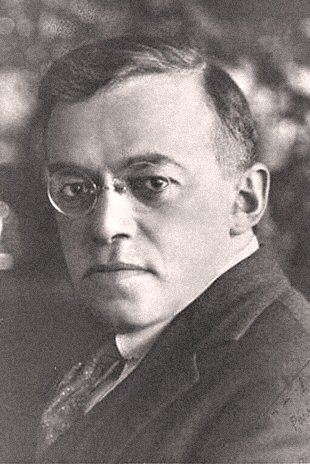 Ze'ev Jabotinsky, founder of Revisionist Zionism Revisionist Zionists, led by Ze'ev Jabotinsky, developed what became known as Nationalist Zionism, whose guiding principles were outlined in the 1923 essay Iron Wall. In 1935 the Revisionists left the World Zionist Organization because it refused to state that the creation of a Jewish state was an objective of Zionism. Jabotinsky believed that, Zionism is a colonising adventure and it therefore stands or falls by the question of armed force. It is important to build, it is important to speak Hebrew, but, unfortunately, it is even more important to be able to shoot—or else I am through with playing at colonization.[168][169] and that Although the Jews originated in the East, they belonged to the West culturally, morally, and spiritually. Zionism was conceived by Jabotinsky not as the return of the Jews to their spiritual homeland but as an offshoot or implant of Western civilization in the East. This worldview translated into a geostrategic conception in which Zionism was to be permanently allied with European colonialism against all the Arabs in the eastern Mediterranean.[170] The revisionists advocated the formation of a Jewish Army in Palestine to force the Arab population to accept mass Jewish migration. Supporters of Revisionist Zionism developed the Likud Party in Israel, which has dominated most governments since 1977. It advocates Israel's maintaining control of the West Bank, including East Jerusalem, and takes a hard-line approach in the Arab–Israeli conflict. In 2005, the Likud split over the issue of creation of a Palestinian state in the occupied territories. Party members advocating peace talks helped form the Kadima Party.[171] Religious Zionism Main article: Religious Zionism Jews praying at the Western Wall. Religious Zionism is an ideology that combines Zionism and observant Judaism. Before the establishment of the State of Israel, Religious Zionists were mainly observant Jews who supported Zionist efforts to build a Jewish state in the Land of Israel. One of the core ideas in Religious Zionism is the belief that the ingathering of exiles in the Land of Israel and the establishment of Israel is Atchalta De'Geulah ("the beginning of the redemption"), the initial stage of the geula.[172] After the Six-Day War and the capture of the West Bank, a territory referred to in Jewish terms as Judea and Samaria, right-wing components of the Religious Zionist movement integrated nationalist revindication and evolved into what is sometimes known as Neo-Zionism. Their ideology revolves around three pillars: the Land of Israel, the People of Israel and the Torah of Israel.[173] Green Zionism Main article: Green Zionism Green Zionism is a branch of Zionism primarily concerned with the environment of Israel. The only specifically environmentalist Zionist party is the Green Zionist Alliance.[citation needed] Post-Zionism During the last quarter of the 20th century, classic nationalism in Israel declined. This led to the rise of post-Zionism. Post-Zionism asserts that Israel should abandon the concept of a "state of the Jewish people" and strive to be a state of all its citizens,[174][better source needed] or a binational state where Arabs and Jews live together while enjoying some type of autonomy.[citation needed] Non-Jewish support Political support for the Jewish return to the Land of Israel predates the formal organization of Jewish Zionism as a political movement. In the 19th century, advocates of the restoration of the Jews to the Holy Land were called Restorationists. The return of the Jews to the Holy Land was widely supported by such eminent figures as Queen Victoria, Napoleon Bonaparte,[175] King Edward VII, President John Adams of the United States, General Smuts of South Africa, President Masaryk of Czechoslovakia, philosopher and historian Benedetto Croce from Italy, Henry Dunant (founder of the Red Cross and author of the Geneva Conventions), and scientist and humanitarian Fridtjof Nansen from Norway.[citation needed] The French government, through Minister M. Cambon, formally committed itself to "... the renaissance of the Jewish nationality in that Land from which the people of Israel were exiled so many centuries ago."[176] In China, top figures of the Nationalist government, including Sun Yat-sen, expressed their sympathy with the aspirations of the Jewish people for a National Home.[177] Christian Zionism Main article: Christian Zionism See also: Christian Zionism in the United Kingdom Martin Luther King Jr. was a notable Christian supporter of Israel and Zionism.[178] Some Christians actively supported the return of Jews to Palestine even prior to the rise of Zionism, as well as subsequently. Anita Shapira, a history professor emerita at Tel Aviv University, suggests that evangelical Christian restorationists of the 1840s 'passed this notion on to Jewish circles'.[179] Evangelical Christian anticipation of and political lobbying within the UK for Restorationism was widespread in the 1820s and common beforehand.[180] It was common among the Puritans to anticipate and frequently to pray for a Jewish return to their homeland.[181][182][183] One of the principal Protestant teachers who promoted the biblical doctrine that the Jews would return to their national homeland was John Nelson Darby. His doctrine of dispensationalism is credited with promoting Zionism, following his 11 lectures on the hopes of the church, the Jew and the gentile given in Geneva in 1840.[184] However, others like C H Spurgeon,[185] both Horatius[186] and Andrew Bonar, Robert Murray M'Chyene,[187] and J C Ryle[188] were among a number of prominent proponents of both the importance and significance of a Jewish return, who were not dispensationalist. Pro-Zionist views were embraced by many evangelicals and also affected international foreign policy. The Russian Orthodox ideologue Hippolytus Lutostansky, also known as the author of multiple antisemitic tracts, insisted in 1911 that Russian Jews should be "helped" to move to Palestine "as their rightful place is in their former kingdom of Palestine".[189] Notable early supporters of Zionism include British Prime Ministers David Lloyd George and Arthur Balfour, American President Woodrow Wilson and British Major-General Orde Wingate, whose activities in support of Zionism led the British Army to ban him from ever serving in Palestine. According to Charles Merkley of Carleton University, Christian Zionism strengthened significantly after the Six-Day War of 1967, and many dispensationalist and non-dispensationalist evangelical Christians, especially Christians in the United States, now strongly support Zionism.[citation needed] Martin Luther King Jr. was a strong supporter of Israel and Zionism,[178] although the Letter to an Anti-Zionist Friend is a work falsely attributed to him. In the last years of his life, the founder of the Latter Day Saint movement, Joseph Smith, declared, "the time for Jews to return to the land of Israel is now." In 1842, Smith sent Orson Hyde, an Apostle of the Church of Jesus Christ of Latter Day Saints, to Jerusalem to dedicate the land for the return of the Jews.[190] Some Arab Christians publicly supporting Israel include US author Nonie Darwish, and former Muslim Magdi Allam, author of Viva Israele,[191] both born in Egypt. Brigitte Gabriel, a Lebanese-born Christian US journalist and founder of the American Congress for Truth, urges Americans to "fearlessly speak out in defense of America, Israel and Western civilization".[192] Muslim Zionism Main article: Muslim Zionism  Israeli Druze Scouts march to Jethro's tomb. Today, thousands of Israeli Druze belong to 'Druze Zionist' movements.[193] Muslims who have publicly defended Zionism include Tawfik Hamid, Islamic thinker and reformer[194] and former member of al-Gama'a al-Islamiyya, an Islamist militant group that is designated as a terrorist organization by the United States and European Union,[195] Sheikh Prof. Abdul Hadi Palazzi, Director of the Cultural Institute of the Italian Islamic Community[196] and Tashbih Sayyed, a Pakistani-American scholar, journalist, and author.[197] On occasion, some non-Arab Muslims such as some Kurds and Berbers have also voiced support for Zionism.[198][199][200] While most Israeli Druze identify as ethnically Arab,[201] today, tens of thousands of Israeli Druze belong to "Druze Zionist" movements.[193] During the Palestine Mandate era, As'ad Shukeiri, a Muslim scholar ('alim) of the Acre area, and the father of PLO founder Ahmad Shukeiri, rejected the values of the Palestinian Arab national movement and was opposed to the anti-Zionist movement.[202] He met routinely with Zionist officials and had a part in every pro-Zionist Arab organization from the beginning of the British Mandate, publicly rejecting Mohammad Amin al-Husayni's use of Islam to attack Zionism.[203] Some Indian Muslims have also expressed opposition to Islamic anti-Zionism. In August 2007, a delegation of the All India Organization of Imams and mosques led by its president Maulana Jamil Ilyas visited Israel. The meeting led to a joint statement expressing "peace and goodwill from Indian Muslims", developing dialogue between Indian Muslims and Israeli Jews, and rejecting the perception that the Israeli–Palestinian conflict is of a religious nature.[204] The visit was organized by the American Jewish Committee. The purpose of the visit was to promote meaningful debate about the status of Israel in the eyes of Muslims worldwide and to strengthen the relationship between India and Israel. It is suggested that the visit could "open Muslim minds across the world to understand the democratic nature of the state of Israel, especially in the Middle East".[205] Hindu support for Zionism Main articles: India–Israel relations and Hindu nationalism After Israel's creation in 1948, the Indian National Congress government opposed Zionism. Some writers have claimed that this was done in order to get more Muslim votes in India (where Muslims numbered over 30 million at the time).[206] Zionism, seen as a national liberation movement for the repatriation of the Jewish people to their homeland then under British colonial rule, appealed to many Hindu nationalists, who viewed their struggle for independence from British rule and the Partition of India as national liberation for long-oppressed Hindus.[citation needed] An international opinion survey has shown that India is the most pro-Israel country in the world.[207] In more current times, conservative Indian parties and organizations tend to support Zionism.[208] This has invited attacks on the Hindutva movement by parts of the Indian left opposed to Zionism, and allegations that Hindus are conspiring with the "Jewish Lobby."[209] Anti-Zionism Main articles: Anti-Zionism and Timeline of Anti-Zionism See also: Non-Zionism, New Antisemitism, Criticism of the Israeli government, and Zionist Occupation Government conspiracy theory 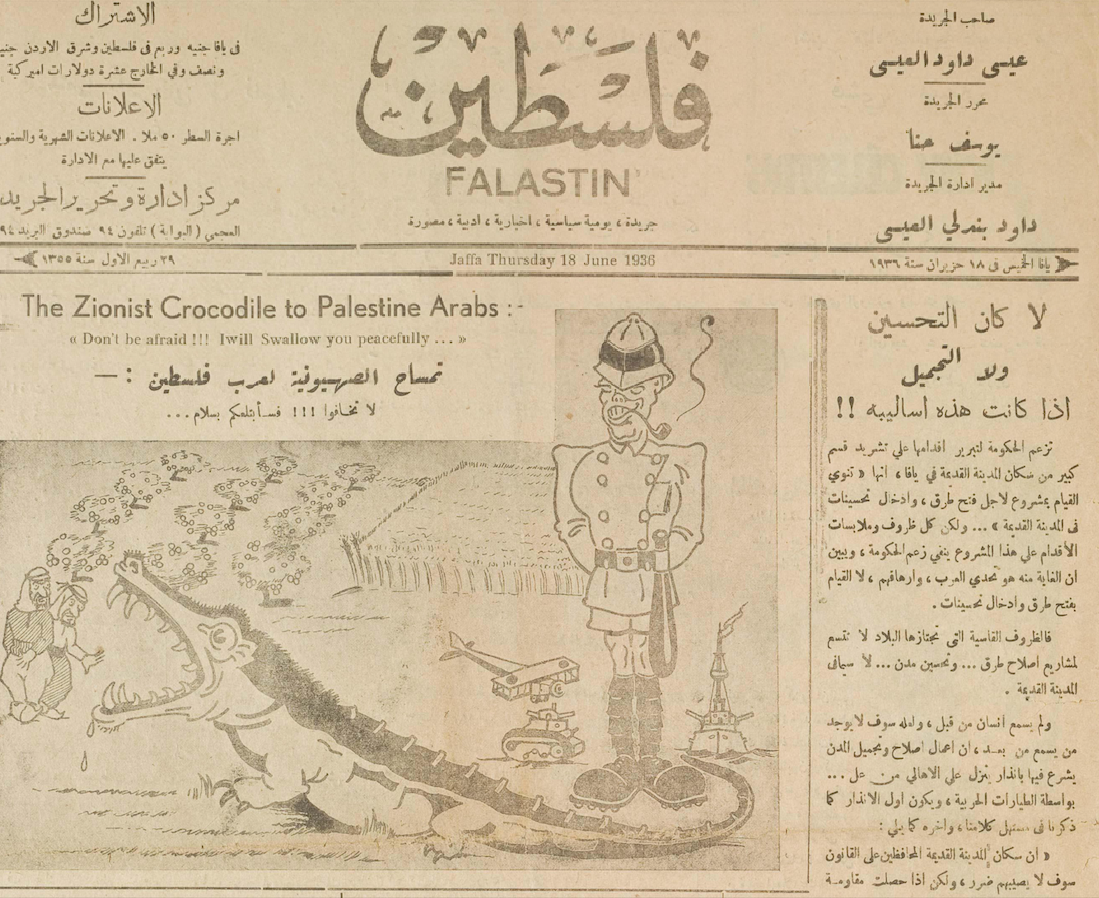 The Palestinian Arab Christian-owned Falastin newspaper featuring a caricature on its June 18, 1936, edition showing Zionism as a crocodile under the protection of a British officer telling Palestinian Arabs: "Don't be afraid!!! I will swallow you peacefully...".[210] Zionism is opposed by a wide variety of organizations and individuals. Among those opposing Zionism there are Palestinian nationalists, states of the Arab League and many of the Muslim world, the former Soviet Union,[211] some secular Jews,[212][213][page needed] and some sects of Judaism such as Satmar Hasidim and Neturei Karta.[214] Reasons for opposing Zionism are varied, and they include: the perception that land confiscations are unfair; expulsions of Palestinians; violence against Palestinians; and alleged racism. Arab states in particular strongly oppose Zionism, which they believe is responsible for the 1948 Palestinian expulsion and flight. The preamble of the African Charter on Human and Peoples' Rights, which has been ratified by 53 African countries as of 2014, includes an undertaking to eliminate Zionism together with other practices including colonialism, neo-colonialism, apartheid, "aggressive foreign military bases" and all forms of discrimination.[215][216] In 1945 US President Franklin D Roosevelt met with king Ibn Saud of Saudi Arabia. Ibn Saud pointed out that it was Germany who had committed crimes against the Jews and so Germany should be punished. Palestinian Arabs had done no harm to European Jews and did not deserve to be punished by losing their land. Roosevelt on return to the US concluded that Israel "could only be established and maintained by force."[217] Catholic Church and Zionism Main articles: Holy See–Israel relations, Supersessionism § Roman Catholicism, and Christianity and antisemitism Shortly after the First Zionist Congress, the semi-official Vatican periodical (edited by the Jesuits) Civiltà Cattolica gave its biblical-theological judgement on political Zionism: "1827 years have passed since the prediction of Jesus of Nazareth was fulfilled ... that [after the destruction of Jerusalem] the Jews would be led away to be slaves among all the nations and that they would remain in the dispersion [diaspora, galut] until the end of the world."[218] The Jews should not be permitted to return to Palestine with sovereignty: "According to the Sacred Scriptures, the Jewish people must always live dispersed and vagabondo [vagrant, wandering] among the other nations, so that they may render witness to Christ not only by the Scriptures ... but by their very existence".[218] Nonetheless, Theodor Herzl travelled to Rome in late January 1904, after the sixth Zionist Congress (August 1903) and six months before his death, looking for support. On January 22, Herzl first met the Papal Secretary of State, Cardinal Rafael Merry del Val. According to Herzl's private diary notes, the Cardinal's interpretation of the history of Israel was the same as that of the Catholic Church, but he also asked for the conversion of the Jews to Catholicism. Three days later, Herzl met Pope Pius X, who replied to his request of support for a Jewish return to Israel in the same terms, saying that "we are unable to favor this movement. We cannot prevent the Jews from going to Jerusalem, but we could never sanction it ... The Jews have not recognized our Lord, therefore we cannot recognize the Jewish people." In 1922, the same periodical published a piece by its Viennese correspondent, "anti-Semitism is nothing but the absolutely necessary and natural reaction to the Jews' arrogance... Catholic anti-Semitism—while never going beyond the moral law—adopts all necessary means to emancipate the Christian people from the abuse they suffer from their sworn enemy".[219] This initial attitude changed over the next 50 years, until 1997, when at the Vatican symposium of that year, Pope John Paul II rejected the Christian roots of antisemitism, stating that "... the wrong and unjust interpretations of the New Testament relating to the Jewish people and their supposed guilt [in Christ's death] circulated for too long, engendering sentiments of hostility toward this people."[220] Characterization as colonialist and racist See also: Racism in Israel § Zionism, Israel and apartheid, and Soviet anti-Zionism David Ben-Gurion stated that "There will be no discrimination among citizens of the Jewish state on the basis of race, religion, sex, or class."[221] Likewise, Vladimir Jabotinsky avowed "the minority will not be rendered defenseless... [the] aim of democracy is to guarantee that the minority too has influence on matters of state policy."[222] Supporters of Zionism, such as Chaim Herzog, argue that the movement is non-discriminatory and contains no racist aspects.[223][better source needed] 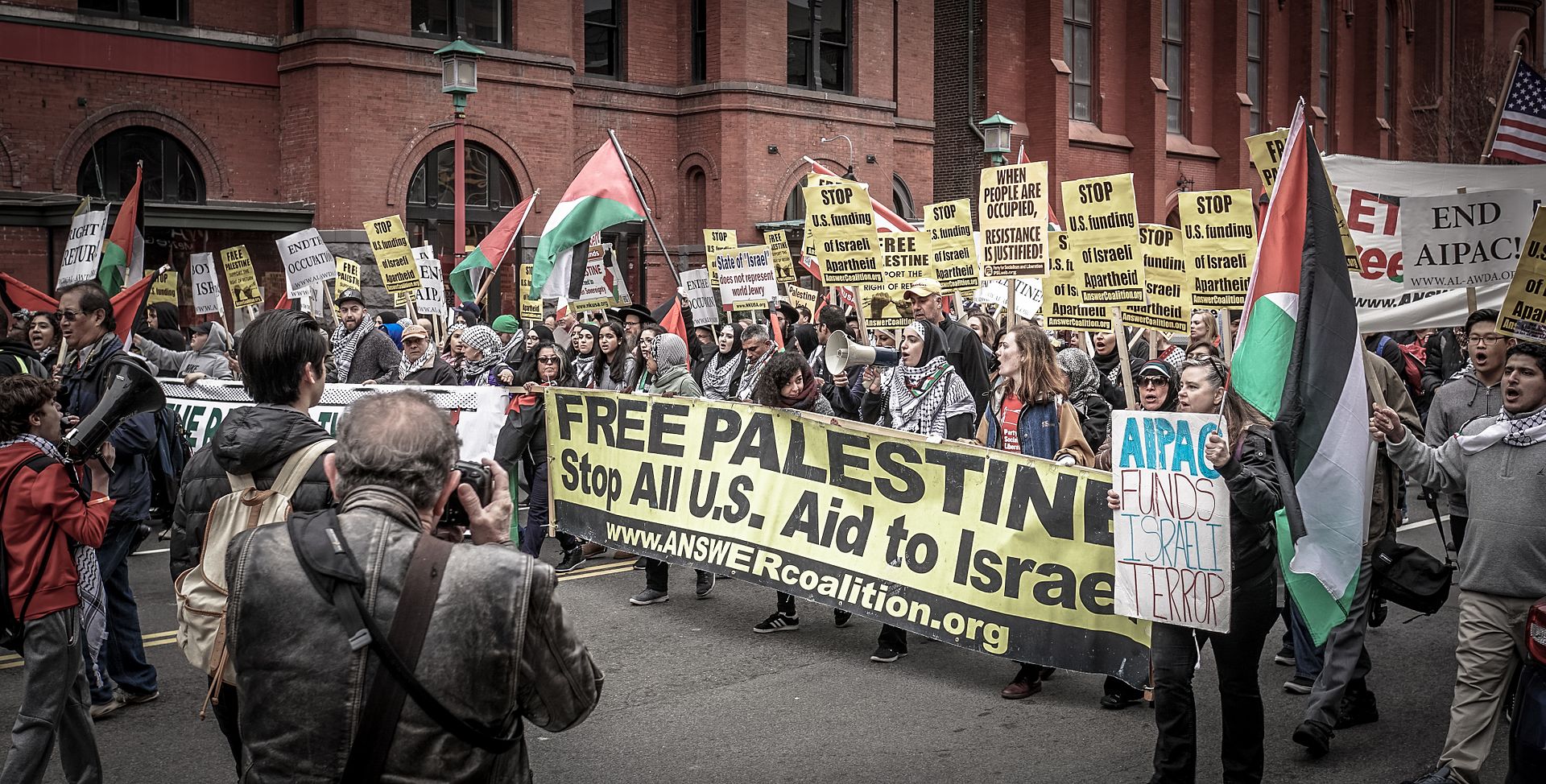 Pro-Palestinian protest with placards demanding the US to stop funding of "Israeli apartheid" in Washington, DC, 2017 However, some critics of Zionism consider it a colonialist[23] or racist[24] movement. According to historian Avi Shlaim, throughout its history up to present day, Zionism "is replete with manifestations of deep hostility and contempt towards the indigenous population." Shlaim balances this by pointing out that there have always been individuals within the Zionist movement that have criticized such attitudes. He cites the example of Ahad Ha'am, who after visiting Palestine in 1891, published a series of articles criticizing the aggressive behaviour and political ethnocentrism of Zionist settlers. Ha'am reportedly wrote that the Yishuv "behave towards the Arabs with hostility and cruelty, trespass unjustly upon their boundaries, beat them shamefully without reason and even brag about it, and nobody stands to check this contemptible and dangerous tendency" and that they believed that "the only language that the Arabs understand is that of force."[224] Some criticisms of Zionism claim that Judaism's notion of the "chosen people" is the source of racism in Zionism,[225] despite, according to Gustavo Perednik, that being a religious concept unrelated to Zionism.[226] This characterization of Zionism as a colonialism has been made by, among others, Gershon Shafir, Michael Prior, Ilan Pappe, and Baruch Kimmerling.[23] Noam Chomsky, John P. Quigly, Nur Masalha, and Cheryl Rubenberg have criticized Zionism, saying that it unfairly confiscates land and expels Palestinians.[227] Isaac Deutscher has called Israelis the 'Prussians of the Middle East', who have achieved a 'totsieg', a 'victorious rush into the grave' as a result of dispossessing 1.5 million Palestinians. Israel had become the 'last remaining colonial power' of the twentieth century.[228] Saleh Abdel Jawad, Nur Masalha, Michael Prior, Ian Lustick, and John Rose have criticized Zionism for having been responsible for violence against Palestinians, such as the Deir Yassin massacre, Sabra and Shatila massacre, and Cave of the Patriarchs massacre.[229] Edward Said and Michael Prior claim that the notion of expelling the Palestinians was an early component of Zionism, citing Herzl's diary from 1895 which states "we shall endeavour to expel the poor population across the border unnoticed—the process of expropriation and the removal of the poor must be carried out discreetly and circumspectly."[230] This quotation has been critiqued by Efraim Karsh for misrepresenting Herzl's purpose.[231][better source needed] He describes it as "a feature of Palestinian propaganda", writing that Herzl was referring to the voluntary resettlement of squatters living on land purchased by Jews, and that the full diary entry stated, "It goes without saying that we shall respectfully tolerate persons of other faiths and protect their property, their honor, and their freedom with the harshest means of coercion. This is another area in which we shall set the entire world a wonderful example ... Should there be many such immovable owners in individual areas [who would not sell their property to us], we shall simply leave them there and develop our commerce in the direction of other areas which belong to us."[232][233] Derek Penslar says that Herzl may have been considering either South America or Palestine when he wrote the diary entry about expropriation.[234] According to Walter Laqueur, although many Zionists proposed transfer, it was never official Zionist policy and in 1918 Ben-Gurion "emphatically rejected" it.[235] The exodus of the Arab Palestinians during the 1947-1949 war has been controversially described as having involved ethnic cleansing.[236][237] According to a growing consensus between 'new historians' in Israel and Palestinian historians, expulsion and destruction of villages played a part in the origin of the Palestinian refugees.[238] While British scholar Efraim Karsh states that most of the Arabs who fled left of their own accord or were pressured to leave by their fellow Arabs, despite Israeli attempts to convince them to stay,[239][240] 'New historians' dismiss this claim,[241] and as such, Beny Morris concur that Arab instigation was not the major cause of the refugees' flight,[242] and state that the major cause of Palestinian flight was instead military actions by the Israeli Defence Force and fear of them and that Arab instigation can only explain a small part of the exodus and not a large part of it.[243][244][245][246][247][248] Ilan Pappe said that Zionism resulted in ethnic cleansing.[249] This view diverges from other New Historians, such as Benny Morris, who place the Palestinian exodus in the context of war, not ethnic cleansing.[250] When Benny Morris was asked about the Expulsion of Palestinians from Lydda and Ramle, he responded "There are circumstances in history that justify ethnic cleansing. I know that this term is completely negative in the discourse of the 21st century, but when the choice is between ethnic cleansing and genocide—the annihilation of your people—I prefer ethnic cleansing."[251] In 1938, Mahatma Gandhi said in the letter "The Jews", that the establishment of a Jewish national home in Palestine must be performed by non-violence against the Arabs, comparing it to the Partition of India into Hindu and Muslim countries, he proposed to the Jews to "offer themselves to be shot or thrown into the Dead Sea without raising a little finger against them".[252] He expressed his "sympathy" for the Jewish aspirations, but said: "The cry for the national home for the Jews does not make much appeal to me. The sanction for it is sought in the Bible and the tenacity with which the Jews have hankered after return to Palestine. Why should they not, like other peoples of the earth, make that country their home where they are born and where they earn their livelihood?"[253][better source needed] and warned them against violence: "It is wrong and inhuman to impose the Jews on the Arabs ... Surely it would be a crime against humanity to reduce the proud Arabs so that Palestine can be restored to the Jews partly or wholly as their national home ... They can settle in Palestine only by the goodwill of the Arabs. They should seek to convert the Arab heart".[254] Gandhi later told American journalist Louis Fischer in 1946 that "Jews have a good case in Palestine. If the Arabs have a claim to Palestine, the Jews have a prior claim".[255] He expressed himself again in 1946, nuancing his views: "Hitherto I have refrained practically from saying anything in public regarding the Jew-Arab controversy. I have done so for good reasons. That does not mean any want of interest in the question, but it does mean that I do not consider myself sufficiently equipped with knowledge for the purpose". He concluded: If they were to adopt the matchless weapon of non-violence ... their case would be the world's and I have no doubt that among the many things that the Jews have given to the world, this would be the best and the brightest".[256][better source needed] In December 1973, the UN passed a series of resolutions condemning South Africa and included a reference to an "unholy alliance between Portuguese colonialism, Apartheid and Zionism."[257] At the time there was little cooperation between Israel and South Africa,[258] although the two countries would develop a close relationship during the 1970s.[259] Parallels have also been drawn between aspects of South Africa's apartheid regime and certain Israeli policies toward the Palestinians, which are seen as manifestations of racism in Zionist thinking.[260] In 1975 the UN General Assembly passed Resolution 3379, which said "Zionism is a form of racism and racial discrimination". According to the resolution, "any doctrine of racial differentiation of superiority is scientifically false, morally condemnable, socially unjust, and dangerous." The resolution named the occupied territory of Palestine, Zimbabwe, and South Africa as examples of racist regimes. Resolution 3379 was pioneered by the Soviet Union and passed with numerical support from Arab and African states amidst accusations that Israel was supportive of the apartheid regime in South Africa.[261] In 1991 the resolution was repealed with UN General Assembly Resolution 46/86,[262][better source needed] after Israel declared that it would only participate in the Madrid Conference of 1991 if the resolution were revoked.[263] Arab countries sought to associate Zionism with racism in connection with a 2001 UN conference on racism, which took place in Durban, South Africa,[264] which caused the United States and Israel to walk away from the conference as a response. The final text of the conference did not connect Zionism with racism. A human rights forum arranged in connection with the conference, on the other hand, did equate Zionism with racism and censured Israel for what it called "racist crimes, including acts of genocide and ethnic cleansing".[265] Haredi Judaism and Zionism See also: Haredim and Zionism Some Haredi Orthodox organizations reject Zionism as they view it as a secular movement and reject nationalism as a doctrine. Hasidic groups in Jerusalem, most famously the Satmar Hasidim, as well as the larger movement they are part of, the Edah HaChareidis, are opposing its ideology for religious reasons. They number in the tens of thousands in Jerusalem, and hundreds of thousands worldwide.[citation needed] One of the best known Hasidic opponents of political Zionism was Hungarian rebbe and Talmudic scholar Joel Teitelbaum. 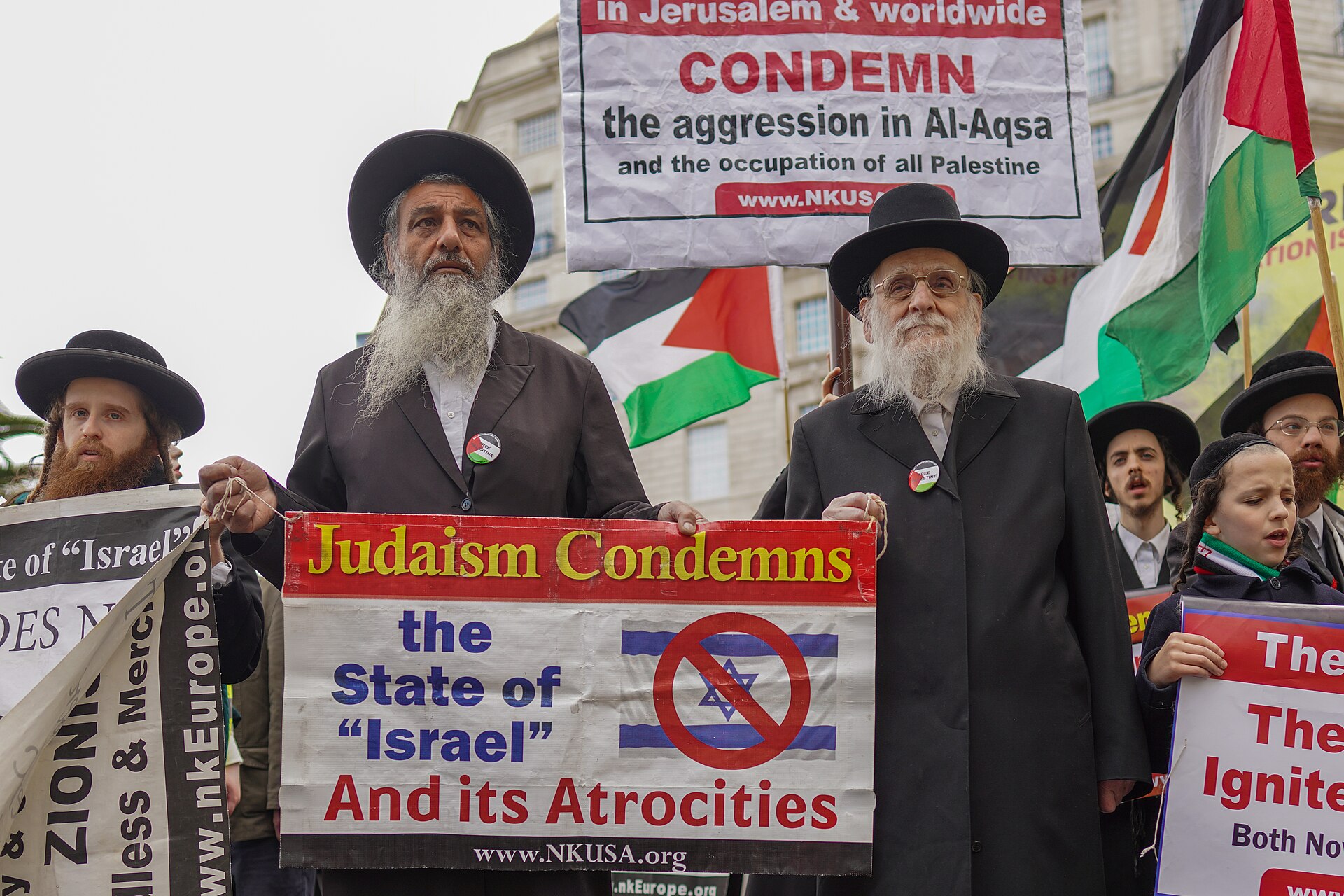 Members of Neturei Karta holding Palestinian flags and placards saying that "Judaism condemns the state of Israel and its atrocities" in London, 2022 The Neturei Karta, an Orthodox Haredi sect viewed as a cult on the "farthest fringes of Judaism" by most mainstream Jews, reject Zionism.[266] The Anti-Defamation League estimates that fewer than 100 members of the community (around 5,000 members[267][better source needed]), actually take part in anti-Israel activism.[266] Some have said that Israel is a "racist regime",[268] compared Zionists to Nazis,[269] claimed that Zionism is contrary to the teachings of the Torah,[270] or accused it of promoting antisemitism.[271] According to the Anti-Defamation League, members of Neturei Karta have a history of extremist statements and support for notable antisemites and Islamic extremists.[266] Anti-Zionism or antisemitism Main articles: Anti-Zionism § Anti-Zionism and antisemitism, and New Antisemitism Critics of anti-Zionism have argued that opposition to Zionism can be hard to distinguish from antisemitism,[272][273] and that criticism of Israel may be used as an excuse to express viewpoints that might otherwise be considered antisemitic.[274][275] In discussion of the relationship between antisemitism and anti-Zionism, "one theory holds that anti-Zionism is no more than veiled anti-Semitism". This is contrasted with the theory "that criticism has of Israeli politics has been discredited as anti-Zionism, and thus linked with anti-Semitism, in order to prevent such criticism".[276] In the Arab world, the words "Jew" and "Zionist" are often used interchangeably. To avoid accusations of antisemitism, the Palestine Liberation Organization has historically avoided using the word "Jewish" in favor of using "Zionist," though PLO officials have sometimes slipped.[277] Some antisemites have alleged that Zionism was, or is, part of a Jewish plot to take control of the world.[278] One particular version of these allegations, "The Protocols of the Elders of Zion" achieved global notability. A 1920 German version renamed them "The Zionist Protocols".[279] The protocols were extensively used as propaganda by the Nazis and remain widely distributed in the Arab world. They are referred to in the 1988 Hamas charter.[280] Anti-Zionist writers such as Noam Chomsky, Norman Finkelstein, Michael Marder, and Tariq Ali have argued that the characterization of anti-Zionism as antisemitic obscures legitimate criticism of Israel's policies and actions, and that it is used as a political ploy in order to stifle legitimate criticism of Israel. Linguist Noam Chomsky argues: "There have long been efforts to identify anti-Semitism and anti-Zionism in an effort to exploit anti-racist sentiment for political ends; "one of the chief tasks of any dialogue with the Gentile world is to prove that the distinction between anti-Semitism and anti-Zionism is not a distinction at all," Israeli diplomat Abba Eban argued, in a typical expression of this intellectually and morally disreputable position (Eban, Congress Bi-Weekly, March 30, 1973). But that no longer suffices. It is now necessary to identify criticism of Israeli policies as anti-Semitism—or in the case of Jews, as "self-hatred," so that all possible cases are covered." – Chomsky, 1989 "Necessary Illusions". Philosopher Michael Marder argues: "To deconstruct Zionism is ... to demand justice for its victims—not only for the Palestinians, who are suffering from it, but also for the anti-Zionist Jews, 'erased' from the officially consecrated account of Zionist history. By deconstructing its ideology, we shed light on the context it strives to repress and on the violence it legitimises with a mix of theological or metaphysical reasoning and affective appeals to historical guilt for the undeniably horrific persecution of Jewish people in Europe and elsewhere."[281] American political scientist Norman Finkelstein argues that anti-Zionism and often just criticism of Israeli policies have been conflated with antisemitism, sometimes called new antisemitism for political gain: "Whenever Israel faces a public relations débâcle such as the Intifada or international pressure to resolve the Israel-Palestine conflict, American Jewish organizations orchestrate this extravaganza called the 'new anti-Semitism.' The purpose is several-fold. First, it is to discredit any charges by claiming the person is an anti-Semite. It's to turn Jews into the victims, so that the victims are not the Palestinians any longer. As people like Abraham Foxman of the ADL put it, the Jews are being threatened by a new holocaust. It's a role reversal—the Jews are now the victims, not the Palestinians. So it serves the function of discrediting the people leveling the charge. It's no longer Israel that needs to leave the Occupied Territories; it's the Arabs who need to free themselves of the anti-Semitism."[282] Marcus Garvey and Black Zionism See also: Alliance of Black Jews and Back-to-Africa movement Zionist success in winning British support for the formation of a Jewish National Home in Palestine helped inspire the Jamaican Black nationalist Marcus Garvey to form a movement dedicated to returning Americans of African origin to Africa. During a speech in Harlem in 1920, Garvey stated: "other races were engaged in seeing their cause through—the Jews through their Zionist movement and the Irish through their Irish movement—and I decided that, cost what it might, I would make this a favorable time to see the Negro's interest through."[283] Garvey established a shipping company, the Black Star Line, to allow Black Americans to emigrate to Africa, but for various reasons he failed in his endeavor. Garvey helped inspire the Rastafari movement in Jamaica, the Black Jews[284] and the African Hebrew Israelites of Jerusalem who initially moved to Liberia before settling in Israel. |
シオニズムのタイプ 多 国籍で世界的なシオニスト運動は、代表民主主義の原則に基づいて構成されている。大会は4年ごとに開催され(第二次世界大戦前は2年ごとに開催)、大会の 代表は会員によって選出される。会員はシェケルと呼ばれる会費を支払う必要がある。大会で代議員は30人の執行委員会を選出し、執行委員会が運動の指導者 を選出する。運動は発足当初から民主的であり、女性にも選挙権があった[156]。 1917年まで、世界シオニスト機構は、持続的な小規模移民と、ユダヤ人国民基金(1901年-ユダヤ人入植のための土地を購入する慈善団体)やアングロ =パレスティナ銀行(1903年-ユダヤ人の事業や農民に融資を提供)などの組織の設立を通じて、ユダヤ人のナショナルホームを建設するという戦略を追求 していた。1942年、ビルトモア会議において、運動はイスラエルの地にユダヤ人国家を樹立するという明確な目的を初めて盛り込んだ[157]。 1968年にエルサレムで開催された第28回シオニスト会議は、「エルサレム・プログラム」の5つのポイントを今日のシオニズムの目的として採択した。そ れらは以下の通りである[158]。 ユダヤ人の統一とユダヤ人の生活におけるイスラエルの中心性 あらゆる国からのアリアを通じて、ユダヤ民族がその歴史的祖国であるエレツ・イスラエルに集結すること。 正義と平和という預言的ビジョンに基づくイスラエル国家の強化 ユダヤ人とヘブライ人の教育、ユダヤ人の精神的・文化的価値の育成を通じたユダヤ人のアイデンティティの維持 あらゆる場所におけるユダヤ人の権利の保護 近代イスラエルが誕生して以来、運動の役割は低下した。現在ではイスラエル政治における周辺的な要素となっているが、シオニズムに対するさまざまな認識は イスラエルとユダヤ人の政治的議論において役割を果たし続けている[159]。 労働シオニズム 主な記事 労働シオニズム  今日、労働シオニズムの「貴族」と評されるイスラエルの作家アモス・オズ[160]。 社会主義シオニスト青年運動ノーアルに所属するイスラエルのユダヤ人青年とユダヤ人抵抗運動家シムチャ・ロテム。1924年に設立されたノアルは、最大の シオニスト青年運動のひとつである。 労働シオニズムは東ヨーロッパで生まれた。社会主義シオニストは、反ユダヤ主義社会における何世紀にもわたる抑圧が、ユダヤ人をおとなしく、脆弱で、絶望 的な存在に追いやり、さらなる反ユダヤ主義を招いたと考えた。彼らは、ユダヤ人の魂と社会の革命が必要であり、それはユダヤ人がイスラエルに移住し、自分 たちの国で農民、労働者、兵士となることで達成可能であると主張した。社会主義シオニストの多くは、伝統的な宗教的ユダヤ教の遵守がユダヤ人の「ディアス ポラ精神」を永続させるとして否定し、イスラエルに「キブツジム」と呼ばれる農村コミューンを設立した。キブツは、ユダヤ民族基金が訓練された監督の下で ユダヤ人労働者を雇用する協同農業の一形態である「国民農場」計画のバリエーションとして始まった。キブツジムは、共同体主義と平等主義を非常に重視し、 ユートピア社会主義をある程度象徴しているという点で、第二アリアの象徴であった。さらに、労働シオニズムの本質的な側面となった自給自足を強調した。社 会主義シオニズムは、ユダヤ教の基本的価値観と精神性にインスピレーションを受け、哲学的に基礎を置いているが、そのユダヤ教の進歩的表現は、しばしば正 統派ユダヤ教と対立的な関係を育んできた[要出典]。 労働シオニズムは、イギリスのパレスチナ委任統治時代にイシュヴの政治的・経済的生活において支配的な勢力となり、1977年の選挙でイスラエル労働党が 敗北するまで、イスラエルの政治体制の支配的なイデオロギーであった。イスラエル労働党はその伝統を受け継いでいるが、キブジムで最も人気のある政党はメ レツである[161]。労働シオニズムの主要機関はヒスタドルート(労働組合の総組織)で、1920年にパレスチナ人労働者のストライキに対してスト破り を提供することから始まり、1970年代まではイスラエル政府に次ぐイスラエル最大の雇用主であった[162]。 自由主義シオニズム 主な記事 一般シオニスト  1948年のアラブ・イスラエル戦争時のミシュマル・ヘメクでのキブツニキヨ(キブツの女性メンバー)。キブツは労働シオニズムの歴史的中心地である。 一般シオニズム(または自由主義シオニズム)は、1897年の第1回シオニスト会議から第1次世界大戦後まで、当初はシオニズム運動の中で支配的な傾向で あった。一般シオニストは、ヘルツェルやチャイム・ワイズマンなど多くのシオニスト指導者が目指した、ヨーロッパのリベラルな中産階級と同一視していた。 リベラル・シオニズムは、現代イスラエルではどの政党とも結びついてはいないが、自由市場主義、民主主義、人権の遵守を主張するイスラエル政治の強い傾向 として残っている。彼らの政治部門は、現代のリクードの祖先のひとつである。しかし、2000年代にリクードから分裂し、現在は消滅した中道政党カディマ は、自由シオニスト・イデオロギーの基本政策の多くに同調し、イスラエルにより民主的な社会を形成するためにはパレスチナの国家化が必要であると主張し、 自由市場を肯定し、イスラエルのアラブ系市民にも平等な権利を求めた。2013年、アリ・シャヴィットは、当時の新党イェス・アティド(世俗的で中流階級 の利益を代表する)の成功が「新しい一般シオニスト」の成功を体現していると示唆した[163][要出典]。 ドロール・ツァイガーマンは、一般シオニストの伝統的な立場-「社会正義、法と秩序、国家と宗教の問題における多元主義、そして外交政策と安全保障の領域 における節度と柔軟性に基づくリベラルな立場」-は、特定の活動的な政党内の重要なサークルや潮流によって依然として支持されていると書いている [164]。 哲学者のカルロ・ストレンガーは、右派のロマンチックなナショナリズムや超正統派のネツァ・イスラエルとは対照的な、ヘルツルとアハド・ハアムのイデオロ ギーに根ざした現代版のリベラル・シオニズム(彼の「知識国家イスラエル」のビジョンを支持する)について述べている。その特徴は、民主的価値と人権への 関心、不誠実と非難されることなく政府の政策を批判する自由、公的生活における過度の宗教的影響力の拒絶である。「リベラル・シオニズムは、ユダヤ人の伝 統の最も真正な特徴を称えるものである。すなわち、鋭い議論への意欲、ダヴカの逆張り精神、権威主義に屈しない姿勢などである。しかし、彼らはまた、この 国家は自由民主主義でなければならないと考えており、それは宗教、民族、性別に関係なく、法の下に厳格に平等でなければならないことを意味する」 [167]。 修正主義シオニズム 主な記事 修正シオニズム  修正シオニズムの創始者ゼエヴ・ジャボチンスキー ゼエヴ・ジャボチンスキーに率いられた修正主義シオニストは、1923年のエッセイ『鉄の壁』でその指導原理を概説した民族主義シオニズムとして知られる ようになったものを発展させた。1935年、修正主義者たちは世界シオニスト機構を脱退した。世界シオニスト機構は、ユダヤ人国家の建設がシオニズムの目 的であることを表明することを拒否したからである。 ジャボチンスキーは次のように考えていた、 シオニズムは植民地化の冒険であり、したがって武力の問題によって成り立つか否かが決まる。建設することは重要であり、ヘブライ語を話すことも重要である が、残念ながら、撃つことができることはさらに重要である。 そして ユダヤ人は東洋に起源を持つが、文化的、道徳的、精神的には西洋に属していた。シオニズムはジャボチンスキーによって、ユダヤ人の精神的祖国への帰還とし てではなく、東洋における西洋文明の分派あるいは移植として構想された。この世界観は、シオニズムが地中海東部のすべてのアラブ人に対してヨーロッパの植 民地主義と永久に同盟を結ぶという地政学的な構想に変換された[170]。 修正主義者たちは、アラブ系住民にユダヤ人の大量移住を受け入れさせるために、パレスチナにユダヤ軍を結成することを提唱した。 修正主義シオニズムの支持者たちは、1977年以来ほとんどの政府を支配しているイスラエルのリクード党を発展させた。東エルサレムを含むヨルダン川西岸 地区をイスラエルが支配し続けることを主張し、アラブ・イスラエル紛争では強硬な姿勢をとる。2005年、リクードは占領地でのパレスチナ国家樹立問題を めぐって分裂した。和平交渉を主張する党員はカディマ党の結成に協力した[171]。 宗教シオニズム 主な記事 宗教シオニズム 西の壁で祈るユダヤ人 宗教シオニズムは、シオニズムとユダヤ教の遵守を組み合わせたイデオロギーである。イスラエル建国以前は、宗教シオニストは主に、イスラエルの地にユダヤ 人国家を建設しようとするシオニストの努力を支持する遵守派のユダヤ人であった。宗教的シオニズムの核となる思想のひとつは、イスラエルの地に亡命者を集 め、イスラエルを建国することが、ゲウラの初期段階であるアチャルタ・デ・ゲウラ(「救済の始まり」)であるという信念である[172]。 六日間戦争と、ユダヤ教用語でユダヤとサマリアと呼ばれるヨルダン川西岸地区の占領後、宗教シオニスト運動の右派構成員は民族主義的復権を統合し、ネオ・ シオニズムとして知られるものへと発展した。彼らのイデオロギーは、イスラエルの土地、イスラエルの人々、イスラエルの律法という3つの柱を中心に展開さ れている[173]。 グリーン・シオニズム 主な記事 緑のシオニズム グリーン・シオニズムは、主にイスラエルの環境を重視するシオニズムの一派である。シオニズムの中で環境保護に特化した政党は「緑のシオニスト同盟」だけ である[要出典]。 ポスト・シオニズム 20世紀最後の四半世紀、イスラエルでは古典的なナショナリズムが衰退した。その結果、ポスト・シオニズムが台頭した。ポスト・シオニズムは、イスラエル が「ユダヤ民族の国家」という概念を放棄し、全市民の国家[174][要出典]、あるいはアラブ人とユダヤ人が何らかの自治を享受しながら共存する二国国 家を目指すべきだと主張している[要出典]。 ユダヤ人以外の支持 ユダヤ人のイスラエルへの帰還に対する政治的支持は、ユダヤ・シオニズムが政治運動として正式に組織される以前からあった。19世紀には、ユダヤ人の聖地 復帰を支持する人々は復帰論者と呼ばれていた。ユダヤ人の聖地帰還は、ヴィクトリア女王、ナポレオン・ボナパルト、エドワード7世[175]、アメリカの ジョン・アダムス大統領、南アフリカのスマッツ将軍、チェコスロバキアのマサリク大統領、イタリアの哲学者・歴史家のベネデット・クローチェ、赤十字の創 設者でありジュネーブ条約の著者であるアンリ・デュナン、ノルウェーの科学者・人道主義者のフリットヨフ・ナンセンなどの著名人によって広く支持された [要出典]。 フランス政府は、カンボン大臣を通じて、「......イスラエルの人々が何世紀も前に追放された地におけるユダヤ民族のルネッサンス」に正式にコミット した[176]。 中国では、孫文ら国民党政府の要人たちが、ナショナル・ホームを求めるユダヤ人の願望に共感を表明した[177]。 キリスト教シオニズム 主な記事 キリスト教シオニズム 以下も参照: イギリスのキリスト教シオニズム  マーティン・ルーサー・キング・ジュニアは、イスラエルとシオニズムを支持する著名なキリスト教徒であった[178]。 一部のキリスト教徒は、シオニズムが台頭する以前から、またその後も、パレスチナへのユダヤ人の帰還を積極的に支持していた。テルアビブ大学の歴史学名誉 教授であるアニタ・シャピラは、1840年代の福音主義キリスト教の復古主義者たちが「この考え方をユダヤ人サークルに伝えた」ことを示唆している [179]。 1820年代には、復古主義に対する福音主義キリスト教の予期と英国内での政治的なロビー活動が広まっており、それ以前にも一般的であった[180]。 ピューリタンの間では、ユダヤ人の祖国への帰還を予期し、頻繁に祈ることが一般的であった[181][182][183]。 ユダヤ人が祖国に帰還するという聖書の教義を推進したプロテスタントの主要な教師の一人がジョン・ネルソン・ダービーであった。しかし、C・H・スポル ジョン[185]、ホラティウス[186]とアンドリュー・ボナー、ロバート・マレー・エムシャイン[187]、J・C・ライル[188]のような、ディ スペンセーション主義者ではないが、ユダヤ人の帰還の重要性と意義の両方を提唱する著名な支持者もいた。シオニスト寄りの見解は多くの福音派に受け入れら れ、国際的な外交政策にも影響を与えた。 ロシア正教会のイデオローグであるヒッポリュトゥス・ルトスタンスキーは、複数の反ユダヤ主義的な小冊子の著者としても知られており、1911年にはロシ ア系ユダヤ人が「彼らの正当な居場所はかつてのパレスチナ王国にある」としてパレスチナに移住することを「助ける」べきだと主張していた[189]。 シオニズムの初期の著名な支持者には、イギリスのデイヴィッド・ロイド・ジョージ首相とアーサー・バルフォア首相、アメリカのウッドロー・ウィルソン大統 領、イギリスのオーデ・ウィンゲート少将がいる。カールトン大学のチャールズ・マークリーによれば、キリスト教シオニズムは1967年の6日間戦争後に著 しく強化され、多くのディスペンセーション主義者や非ディスペンセーション主義者の福音主義キリスト教徒、特に米国のキリスト教徒は現在、シオニズムを強 く支持している[要出典]。 マーティン・ルーサー・キング・ジュニアはイスラエルとシオニズムの強力な支持者であった[178]。 末日聖徒運動の創始者ジョセフ・スミスは晩年、"ユダヤ人がイスラエルの地に帰還する時は今である "と宣言した。1842年、スミスは末日聖徒イエス・キリスト教会の使徒オーソン・ハイドをエルサレムに派遣し、ユダヤ人の帰還のためにエルサレムの地を 捧げさせた[190]。 イスラエルを公に支持するアラブ系キリスト教徒には、米国の作家ノニー・ダーウィッシュや、『Viva Israele』の著者である元イスラム教徒のマグディ・アラムがいる[191]。レバノン生まれのクリスチャンである米国のジャーナリストであり、「真 実を求めるアメリカ会議」の創設者であるブリジット・ガブリエルは、「アメリカ、イスラエル、西洋文明を擁護するために恐れずに発言する」よう米国人に促 している[192]。 イスラム・シオニズム 主な記事 イスラム・シオニズム  ジェスロの墓に向かって行進するイスラエルのドルーズ派兵隊。今日、イスラエルの何千人ものドルーズは「ドルーズ・シオニスト」運動に属している [193]。 シオニズムを公に擁護しているイスラム教徒には、イスラム思想家であり改革者[194]であり、米国と欧州連合によってテロ組織として指定されているイス ラム過激派組織であるアル・ガマア・アル・イスラミヤの元メンバーであるタウフィク・ハミド[195]、イタリア・イスラム共同体の文化研究所所長である シェイク・アブドゥル・ハディ・パラッツィ教授[196]、パキスタン系アメリカ人の学者、ジャーナリスト、作家であるタシュビ・サイエドなどがいる [197]。 クルド人やベルベル人などの非アラブ系ムスリムもシオニズム支持を表明することがある[198][199][200]。 ほとんどのイスラエルのドルーズは民族的にアラブ人であると認識しているが[201]、今日では数万人のイスラエルのドルーズが「ドルーズ・シオニスト」 運動に属している[193]。 パレスチナ委任統治時代、アクレ地区のイスラム学者('alim')であり、PLO創設者アフマド・シュケイリの父親であるアスアド・シュケイリは、パレ スチナ・アラブ民族運動の価値観を否定し、反シオニスト運動に反対していた[202]。 彼は日常的にシオニスト高官と会っており、イギリス委任統治時代当初からあらゆる親シオニスト的アラブ組織に参加しており、シオニズムを攻撃するためにイ スラム教を利用したムハンマド・アミン・アル・フサイニを公に否定していた[203]。 インドのイスラム教徒の中にも、イスラムの反シオニズムに反対を表明している者がいる。2007年8月、マウラナ・ジャミル・イリヤス会長率いる全イン ド・イマーム・モスク組織の代表団がイスラエルを訪問した。この会談では、「インドのイスラム教徒による平和と親善」を表明し、インドのイスラム教徒とイ スラエルのユダヤ人との対話を発展させ、イスラエルとパレスチナの紛争が宗教的な性質のものであるという認識を否定する共同声明が発表された[204]。 訪問の目的は、世界中のイスラム教徒の目から見たイスラエルの地位について有意義な議論を促進し、インドとイスラエルの関係を強化することであった。この 訪問は、「世界中のイスラム教徒の心を開き、特に中東におけるイスラエル国家の民主的な性質を理解させる」可能性があると示唆されている[205]。 ヒンドゥー教のシオニズム支持 主な記事 インド・イスラエル関係、ヒンドゥー民族主義 1948年のイスラエル建国後、インド国民会議政府はシオニズムに反対した。シオニズムは、当時イギリスの植民地支配下にあった祖国へのユダヤ人の送還を 求める民族解放運動とみなされており、イギリス支配からの独立とインド分割のための闘争を、長い間抑圧されてきたヒンドゥー教徒の民族解放とみなしていた 多くのヒンドゥー民族主義者にとっては魅力的であった[要出典]。 国際世論調査によれば、インドは世界で最も親イスラエルの国である[207]。より現代においては、インドの保守的な政党や組織はシオニズムを支持する傾 向にある[208]。このことは、シオニズムに反対するインドの左派の一部によるヒンドゥトヴァ運動への攻撃や、ヒンドゥ教徒が「ユダヤ・ロビー」と共謀 しているという疑惑を招いている[209]。 反シオニズム 主な記事 反シオニズム、反シオニズム年表 以下も参照: 非シオニズム、新反ユダヤ主義、イスラエル政府批判、シオニスト占領政府陰謀論  1936年6月18日付のパレスチナ・アラブ系キリスト教徒が所有するファラスティン紙には、シオニズムをワニに見立てた風刺画が掲載された: 「恐れることはない!恐れることはない!!私は平和的にお前たちを飲み込んでやる......」[210]。 シオニズムは、多種多様な組織や個人によって反対されている。シオニズムに反対する人々の中には、パレスチナの民族主義者、アラブ連盟の国々やイスラム世 界の多くの国々、旧ソビエト連邦、[211]一部の世俗的なユダヤ人、[212][213][要出典]、サトマル・ハシディムやネトゥレイ・カルタといっ たユダヤ教の一部の宗派が含まれる[214]。シオニズムに反対する理由は様々であり、土地の没収が不当であるという認識、パレスチナ人の追放、パレスチ ナ人に対する暴力、人種差別の疑いなどが含まれる。特にアラブ諸国はシオニズムに強く反対しており、1948年のパレスチナ人追放と逃亡の責任はシオニズ ムにあると考えている。2014年時点で53のアフリカ諸国が批准しているアフリカ人権憲章の前文には、植民地主義、新植民地主義、アパルトヘイト、「侵 略的な外国の軍事基地」、あらゆる形態の差別を含む他の慣行とともに、シオニズムを排除するという約束が含まれている[215][216]。 1945年、フランクリン・ルーズベルト米大統領はサウジアラビアのイブン・サウド国王と会談した。イブン・サウドは、ユダヤ人に対して犯罪を犯したのは ドイツであり、ドイツは罰せられるべきだと指摘した。パレスチナのアラブ人はヨーロッパのユダヤ人に何の危害も加えておらず、土地を失うことで罰せられる 資格はない。アメリカに帰国したルーズベルトは、イスラエルは「武力によってのみ確立され、維持されうる」と結論づけた[217]。 カトリック教会とシオニズム 主な記事 ローマ教皇庁とイスラエルの関係、超越主義§ローマ・カトリック、キリスト教と反ユダヤ主義 第1回シオニスト会議の直後、バチカンの半公式定期刊行物(イエズス会が編集)『チヴィルタ・カトリカ』は、政治的シオニズムについて聖書神学的な判断を 下した。ナザレのイエスの予言が成就してから1827年が経過し、[エルサレム滅亡の後]ユダヤ人はあらゆる国の奴隷として連れ去られ、世の終わりまで離 散(ディアスポラ、ガルト)にとどまるであろう: 「聖典によれば、ユダヤ民族は、聖典によってのみならず、その存在そのものによってキリストを証しすることができるように、常に他の国々の間に分散し、放 浪して生きなければならない」[218]。 それにもかかわらず、テオドール・ヘルツルは、第6回シオニスト会議(1903年8月)の後、死の6ヶ月前の1904年1月下旬にローマを訪れ、支援を求 めた。1月22日、ヘルツルはローマ教皇庁の国務長官ラファエル・メリー・デル・ヴァル枢機卿に初めて会った。ヘルツルの私的な日記のメモによると、枢機 卿のイスラエル史の解釈はカトリック教会と同じだったが、ユダヤ人のカトリックへの改宗も求めた。その3日後、ヘルツルはローマ教皇ピウス10世に会っ た。ピウス10世は、ユダヤ人のイスラエル帰還を支持するという彼の要請に対して、同じ言葉でこう答えた。私たちはユダヤ人がエルサレムに行くのを阻止す ることはできないが、それを承認することはできない。ユダヤ人はわれわれの主を認めていない。1922年、同誌はウィーン特派員による「反ユダヤ主義は、 ユダヤ人の傲慢さに対する絶対的に必要かつ自然な反応にほかならない。カトリックの反ユダヤ主義は、道徳的な掟を決して超えないが、キリスト教徒の人々を 宿敵から受ける虐待から解放するために必要なあらゆる手段を採用する」[219] この最初の態度は、1997年のバチカンのシンポジウムで、教皇ヨハネ・パウロ二世が反ユダヤ主義のキリスト教的な根源を否定し、次のように述べるまで、 その後50年の間に変化した。 新約聖書におけるユダヤ人に関する誤った不当な解釈と、ユダヤ人が[キリストの死における]罪を犯したとされる解釈があまりにも長い間流布し、ユダヤ人に 対する敵意を生んだ」[220]。 植民地主義者、人種差別主義者としての特徴 以下も参照: イスラエルにおける人種差別 § シオニズム、イスラエルとアパルトヘイト、ソ連の反シオニズム ダヴィド・ベン=グリオンは、「ユダヤ国家の市民の間には、人種、宗教、性別、階級による差別は存在しない」と述べている[221]。同様に、ウラジーミ ル・ジャボチンスキーは、「少数派が無防備になることはない。[民主主義の目的は、少数派も国家の政策事項に影響力を持つことを保証することである」 [222]。チャイム・ヘルツォグのようなシオニズムの支持者は、この運動は非差別的であり、人種差別的な側面を含んでいないと主張する[223][要出 典]。  2017年、ワシントンDCで、「イスラエルのアパルトヘイト」への資金援助を停止するよう米国に要求するプラカードを掲げた親パレスチナ派の抗議活動 しかし、シオニズムを植民地主義[23]や人種差別主義[24]の運動とみなす批判者もいる。歴史家のアヴィ・シュレイムによれば、現在に至るまでの歴史 を通じて、シオニズムは "先住民に対する深い敵意と侮蔑の表明に満ちている"。シュレイムは、シオニズム運動の中にもそうした態度を批判する人物が常にいたことを指摘すること で、このバランスをとっている。彼は1891年にパレスチナを訪れた後、シオニスト入植者の攻撃的な行動と政治的な民族中心主義を批判する一連の記事を発 表した。ハアムは、イシュヴが「アラブ人に対して敵意と残酷さをもって振る舞い、彼らの境界線に不当に侵入し、理由もなく彼らを情けなく打ちのめし、それ を自慢してさえいる。 「シオニズムに対する批判の中には、ユダヤ教の「選ばれし民」という概念がシオニズムにおける人種差別の根源であると主張するものもある[225]。 [226]植民地主義としてのシオニズムのこのような特徴は、特にGershon Shafir、Michael Prior、Ilan Pappe、Baruch Kimmerlingによってなされてきた[23]。 ノーム・チョムスキー、ジョン・P・クイグリー、Nur Masalha、Cheryl Rubenbergは、シオニズムは不当に土地を没収しパレスチナ人を追放していると批判している。 [Isaac Deutscherはイスラエル人を「中東のプロシア人」と呼び、150万人のパレスチナ人を奪い取った結果、「トツィーグ」、つまり「墓場への勝利の突 進」を達成した。サレー・アブデル・ジャワド、ヌール・マサルハ、マイケル・プライヤー、イアン・ラスティック、ジョン・ローズは、シオニズムがデイル・ ヤシンの虐殺、サブラとシャティーラの虐殺、総主教の洞窟の虐殺といったパレスチナ人に対する暴力に責任があると批判している[229]。 エドワード・サイードとマイケル・プライアーは、パレスチナ人を追放するという概念はシオニズムの初期の構成要素であったと主張し、1895年のヘルツル の日記を引用して、「我々は気付かれないように国境を越えて貧しい住民を追放することに努めなければならない。 [231][要出典]彼はこれを「パレスチナのプロパガンダの特徴」と表現し、ヘルツルが言及していたのはユダヤ人が購入した土地に住む不法占拠者の自発 的な再定住であり、日記の全文には「他の信仰を持つ人々を尊重し、彼らの財産、名誉、自由を最も厳しい強制手段で保護することは言うまでもない。これもま た、われわれが全世界に素晴らしい模範を示すべき分野である.万一、個々の地域にそのような不動所有者[我々に財産を売却しようとしない者]が多数存在す るならば、我々は単に彼らをそこに残し、我々に属する他の地域の方向に我々の商業を発展させるであろう」[232][233] デレク・ペンスラーは、収用についての日記を書いたとき、ヘルツルは南米かパレスチナのどちらかを考えていたかもしれないと述べている[234]。 ウォルター・ラクールによれば、多くのシオニストが移譲を提案したが、それは公式なシオニストの政策では決してなく、1918年にベン・グリオンはそれを 「力強く拒否」した[235]。 1947年から1949年にかけての戦争におけるアラブ系パレスチナ人の追放は、民族浄化を伴うものであったとして議論の的になっている[236] [237]。 イスラエルの「新しい歴史家」とパレスチナの歴史家の間で高まりつつあるコンセンサスによれば、村落の追放と破壊はパレスチナ難民の起源に一役買ってい た。 [238]イギリスの学者エフライム・カーシュは、逃亡したアラブ人のほとんどは、イスラエルが残留するよう説得しようと試みたにもかかわらず、自らの意 思で去ったか、同胞のアラブ人によって去るよう圧力をかけられたと述べているが[239][240]、「新しい歴史家」はこの主張を退けている [241]、 ベニー・モリスは、アラブの扇動は難民の逃亡の主要な原因ではなかったと同調し[242]、パレスチナ人の逃亡の主要な原因は、代わりにイスラエル国防軍 による軍事行動とそれに対する恐怖であり、アラブの扇動は逃亡のごく一部しか説明できず、その大部分は説明できないと述べている。 [243][244][245][246][247][248]イラン・パッペは、シオニズムは民族浄化をもたらしたと述べている。 この見解は、パレスチナ人の脱出を民族浄化ではなく戦争の文脈に置くベニー・モリスのような他のニュー・ヒストリアンと乖離している[250]。 ベニー・モリスはリッダとラムレからのパレスチナ人の追放について質問されたとき、「歴史には民族浄化を正当化する状況がある」と答えている。この言葉が 21世紀の言説において完全に否定的なものであることは承知しているが、民族浄化とジェノサイド(同胞の絶滅)のどちらかを選ぶのであれば、私は民族浄化 を選ぶ」[251]。 1938年、マハトマ・ガンディーは書簡「ユダヤ人」の中で、パレスチナにおけるユダヤ人の民族的故郷の樹立はアラブ人に対する非暴力によって実行されな ければならないと述べ、それをインドのヒンドゥー教国とイスラム教国への分割になぞらえ、ユダヤ人に対して「彼らに対して少しも指一本立てずに、銃殺され るか死海に投げ込まれることを自ら申し出る」ことを提案した[252]: 「ユダヤ人の国民的故郷を求める叫びは、私にはあまり魅力的ではない。その根拠は聖書にあり、ユダヤ人がパレスチナへの帰還を切望する粘り強さにある。な ぜ彼らは、地球の他の人々と同じように、自分たちが生まれ、生計を立てているその国を故郷とすべきではないのだろうか」[253][より良いソースが必 要]と、暴力に対して警告を発した: 「ユダヤ人をアラブ人に押し付けるのは間違っており、非人道的である。確かに、パレスチナの一部または全部をユダヤ人の民族的故郷として回復するために、 誇り高きアラブ人を減少させることは人道に対する罪であろう。彼らはアラブ人の好意によってのみパレスチナに定住することができる。彼らはアラブ人の心を 改心させるよう努めるべきである」[254]。ガンジーは後に、1946年にアメリカのジャーナリスト、ルイス・フィッシャーに、「ユダヤ人はパレスチナ において正当な主張を持っている。アラブ人がパレスチナの領有権を主張するならば、ユダヤ人はそれよりも先に領有権を主張している」[255]: 「これまで私は、ユダヤ人とアラブ人の論争について公の場で発言することを実質的に控えてきた。そうしてきたのには理由がある。だからといって、この問題 に関心がないわけではないが、そのために必要な知識を自分が十分に備えているとは思っていないということだ」。彼はこう締めくくった: もし彼らが非暴力という比類なき武器を採用するならば、......彼らのケースは世界的なものとなるだろうし、ユダヤ人が世界に与えてきた多くのものの 中で、これが最善かつ最良のものであることは疑いない」[256][better source needed]。 1973年12月、国連は南アフリカを非難する一連の決議を可決し、「ポルトガルの植民地主義、アパルトヘイト、シオニズムの間の神聖でない同盟」 [257]への言及を含んでいた。当時、イスラエルと南アフリカの間にはほとんど協力関係はなかったが[258]、両国は1970年代に緊密な関係を築く ことになる。 1975年、国連総会は「シオニズムは人種主義および人種差別の一形態である」とする決議3379を可決した。同決議によれば、"人種差別の優劣を論ずる いかなる教義も、科学的に誤りであり、道徳的に非難されるべきものであり、社会的に不正義であり、危険である"。決議は、人種差別体制の例として、パレス チナ占領地、ジンバブエ、南アフリカを挙げた。決議3379号はソ連によって開拓され、イスラエルが南アフリカのアパルトヘイト政権を支持しているという 非難の中で、アラブ諸国とアフリカ諸国からの多数の支持を得て可決された[261]。1991年、イスラエルが決議が撤回された場合のみ1991年のマド リード会議に参加すると宣言した後、国連総会決議46/86号によって決議が廃止された[262][出典略]。 アラブ諸国は、2001年に南アフリカのダーバンで開催された人種差別に関する国連会議に関連して、シオニズムを人種差別主義と関連付けようとし [264]、これに対して米国とイスラエルは会議から離脱した。この会議の最終文書では、シオニズムと人種差別は関連づけられていなかった。一方、この会 議に関連して開催された人権フォーラムは、シオニズムを人種差別と同一視し、「ジェノサイドと民族浄化を含む人種差別犯罪」と呼ばれる行為についてイスラ エルを非難した[265]。 ハレディ・ユダヤ主義とシオニズム 以下も参照: ハレディムとシオニズム ハレディ正教会の中には、シオニズムを世俗的な運動とみなし、教義としてのナショナリズムを否定する団体もある。エルサレムのハシディズム・グループ、最 も有名なのはサトマル・ハシディムであり、彼らが属するより大きな運動であるエダ・ハチャレイディズも、宗教的理由からそのイデオロギーに反対している。 政治的シオニズムに反対するハシディ教徒の中で最も有名なのは、ハンガリーのリベでありタルムード学者のジョエル・タイテルバウムである。  パレスチナの旗と「ユダヤ教はイスラエル国家とその残虐行為を非難する」というプラカードを掲げるネトゥレイ・カルタのメンバー(2022年、ロンドン) ネトゥレイ・カルタは、ほとんどの主流派ユダヤ人から「ユダヤ教の最果て」にあるカルトとみなされている正統派ハレー派の一派で、シオニズムを拒絶してい る[266]。名誉毀損防止連盟は、この共同体のメンバー(約5,000人[267][より良いソースが必要])のうち、実際に反イスラエル活動に参加し ているのは100人に満たないと推定している。 [266]イスラエルは「人種差別政権」であると発言したり[268]、シオニストをナチスと比較したり[269]、シオニズムは律法の教えに反している と主張したり[270]、反ユダヤ主義を助長していると非難したりする者もいる[271]。 名誉毀損防止連盟によれば、ネトゥレイ・カルタのメンバーは過激な発言をしたり、著名な反ユダヤ主義者やイスラム過激派を支援してきた歴史がある [266]。 反シオニズムまたは反ユダヤ主義 主な記事 反シオニズム§反シオニズムと反ユダヤ主義、新反ユダヤ主義 反シオニズムの批評家たちは、シオニズムへの反対は反ユダヤ主義と区別するのが難しく[272][273]、イスラエルへの批判は、そうでなければ反ユダ ヤ主義とみなされるかもしれない視点を表明するための口実として使われるかもしれないと主張している[274][275]。反ユダヤ主義と反シオニズムの 関係についての議論では、「一説によれば、反シオニズムはベールに包まれた反ユダヤ主義以上のものではない」とされている。これは「イスラエルの政治に対 する批判は、そのような批判を防ぐために反シオニズムとして信用されず、したがって反ユダヤ主義と結びつけられてきた」という説と対照的である [276]。 アラブ世界では、「ユダヤ人」と「シオニスト」という言葉はしばしば同じ意味で使われる。反ユダヤ主義の非難を避けるために、パレスチナ解放機構は歴史的 に「ユダヤ人」という言葉を使うことを避け、「シオニスト」という言葉を使うことを好んできたが、PLO幹部は時々口を滑らせている[277]。 反ユダヤ主義者の中には、シオニズムは世界を支配しようとするユダヤ人の陰謀の一部であると主張する者もいる[278]。これらの主張の特定のバージョン のひとつである「シオンの長老の議定書」は世界的に有名になった。1920年のドイツ語版では「シオニストの議定書」と改名された[279]。議定書はナ チスのプロパガンダとして広範囲に使用され、アラブ世界では今でも広く配布されている。1988年のハマス憲章にも引用されている[280]。 ノーム・チョムスキー、ノーマン・フィンケルシュタイン、マイケル・マーダー、タリク・アリなどの反シオニスト作家は、反シオニズムを反ユダヤ主義として 特徴づけることは、イスラエルの政策や行動に対する正当な批判を曖昧にし、イスラエルに対する正当な批判を封じ込めるための政治的な策略として使われてい ると主張している。 言語学者のノーム・チョムスキーはこう主張する: 「異邦人世界との対話の主要な課題のひとつは、反ユダヤ主義と反シオニズムの区別がまったくないことを証明することである」と、イスラエルの外交官アバ・ エバンは、知的にも道徳的にも評判の悪いこの立場を典型的に表現して主張した(Eban, Congress Bi-Weekly, March 30, 1973)。しかし、それではもはや十分ではない。今では、イスラエルの政策に対する批判を反ユダヤ主義として、あるいはユダヤ人の場合は「自己嫌悪」と して特定し、ありとあらゆるケースをカバーする必要がある。" - チョムスキー、1989年『必要な幻想』。 哲学者マイケル・マーダーはこう主張する: シオニズムを脱構築することは、......その犠牲者のための正義を要求することである。シオニズムに苦しめられているパレスチナ人のためだけでなく、 公式に聖別されたシオニズムの歴史の記述から "消された "反シオニストのユダヤ人のためでもある。シオニストのイデオロギーを解体することによって、私たちは、シオニストが抑圧しようと努めている背景と、神学 的あるいは形而上学的な推論と、ヨーロッパやその他の場所におけるユダヤ人に対する紛れもなく恐ろしい迫害に対する歴史的罪悪感への感情的な訴えを混ぜ合 わせて正当化している暴力に光を当てることができる」[281]。 アメリカの政治学者であるノーマン・フィンケルシュタインは、反シオニズムと、しばしばイスラエルの政策に対する単なる批判が、政治的利益のために反ユダ ヤ主義と混同され、時には新たな反ユダヤ主義と呼ばれていると主張する: イスラエルがインティファーダのような広報上の大失敗や、イスラエルとパレスチナの紛争解決を求める国際的な圧力に直面するたびに、アメリカのユダヤ人団 体は "新しい反ユダヤ主義 "と呼ばれる大騒ぎを組織する。目的はいくつかある。第一に、その人物を反ユダヤ主義者だと主張することで、いかなる罪状も信用させないことである。ユダ ヤ人を被害者に仕立て上げ、被害者がパレスチナ人でなくなるようにするのだ。ADLのアブラハム・フォックスマンが言うように、ユダヤ人は新たなホロコー ストに脅かされているのだ。それは役割の逆転であり、ユダヤ人は今や被害者であり、パレスチナ人ではない。ユダヤ人は今や被害者であり、パレスチナ人では ないのだ。占領地から去る必要があるのはもはやイスラエルではなく、反ユダヤ主義から解放される必要があるのはアラブ人なのだ」[282]。 マーカス・ガーヴィーと黒人シオニズム 以下も参照: 黒人ユダヤ人同盟とアフリカ回帰運動 シオニストがパレスチナにユダヤ人のナショナル・ホームを建設するためにイギリスの支持を得ることに成功したことは、ジャマイカの黒人ナショナリスト、 マーカス・ガーベイに、アフリカ出身のアメリカ人をアフリカに帰すことを目的とする運動を結成するきっかけとなった。1920年のハーレムでの演説で、 ガーヴィーはこう述べた: 「他の人種は、ユダヤ人はシオニスト運動、アイルランド人はアイルランド運動を通じて、自分たちの大義を貫徹しようとしていた。 ガーヴィーは、ジャマイカのラスタファリ運動、黒人ユダヤ人[284]、エルサレムのアフリカ系ヘブライ・イスラエル人の鼓舞に貢献し、彼らは当初リベリ アに移住した後、イスラエルに定住した。 |
| American Council for Judaism Gathering of Israel Golus nationalism Jewish Agency for Israel Jewish Autonomism List of Zionist figures Romanistan Yehud Medinata Zio (pejorative) |
アメリカユダヤ教協議会 イスラエルの集い ゴルス民族主義 ユダヤ人イスラエル機関 ユダヤ人自治主義 シオニストのリスト ロマニスタン イエウド・メディナータ ジオ(侮蔑語) |
| https://en.wikipedia.org/wiki/Zionism |
|
| Zio as pejorative term Zio is a pejorative term for Zionists, commonly used by anti-Zionists and white supremacists. The term is often considered antisemitic, particularly by Zionists. About The American Jewish Committee (AJC) lists "Zio" on their Translate Hate Glossary. The AJC claims that the term "Zio" is used by antisemites to disguise their antisemitism as merely anti-Zionism, asserting that "Zio" is actually a short-hand euphemism for "Jew".[1] Mosaic Magazine has said that "Zio" is a "new anti-Jewish slur".[2] Ben Samuels, writing for Haaretz, has claimed that the term was popularized first by David Duke and then later by leftists and members of the British Labour Party.[3] The Zionist writer Ariel Sobel has also claimed that "Zio" is an antisemitic slur with roots within antisemitic right-wing extremist circles that has been adopted by progressives.[4] "Zio" can be used as a noun or as a hyphenated or unhyphenated adjective. "Zio-Nazi" is a common pejorative term for Zionists. Other variations of "Zio-" include Zio-Communism, Zio-economics, Zio-supremacism, and Zio-occupied America.[2] In 2016, the British Labour Party released an inquiry into antisemitism stating that "Epithets such as...‘Zio’ and others should have no place in Labour party discourse going forward." Speaking at the inquiry's launch, Jeremy Corbyn declared that "‘Zio’ is a vile epithet that follows in a long line of earlier such terms that have no place whatsoever in our party."[5] In 2017, the organizers of the Chicago Dyke March faced accusations of antisemitism after their Twitter account used the term "Zio tears".[6][7][8] Tony Greenstein, a Jewish anti-Zionist from the United Kingdom, was accused of antisemitism in 2018 for using the term "Zios", among other allegations, and was expelled from the British Labour Party.[9][10] |
【ヘイト語としてのシオ・ザイオ】 シオニストに対する蔑称で、反シオニストや白人至上主義者がよく使う。特にシオニストからは反ユダヤ主義的な用語とみなされることが多い。 について 米国ユダヤ人委員会(AJC)は、ヘイト用語集を翻訳する上で「Zio」を挙げている。AJCは、「Zio」という用語は反ユダヤ主義者が自分たちの反ユ ダヤ主義を単なる反シオニズムとして偽装するために使用していると主張し、「Zio」は実際には「Jew」の短縮婉曲表現であると主張している[1]。モ ザイク誌は、「Zio」は「新しい反ユダヤ的中傷」であると述べている[2]。 [2] Haaretz誌に寄稿しているBen Samuelsは、この言葉はまずDavid Dukeによって広まり、後に左翼やイギリス労働党のメンバーによって広まったと主張している[3] 。シオニストである作家Ariel Sobelも、「Zio」は反ユダヤ主義的な右翼過激派界隈に根ざした反ユダヤ主義的な中傷であり、それが進歩主義者によって採用されたと主張している [4]。 "Zio "は名詞として、またはハイフンでくくられた、あるいはくくられていない形容詞として使われる。「ジオ=ナチ」はシオニストに対する一般的な蔑称である。 Zio-」の他のバリエーションには、Zio-Communism、Zio-economics、Zio-supremacism、Zio- occupied Americaなどがある[2]。 2016年、イギリス労働党は反ユダヤ主義に関する調査結果を発表し、"Zio "などの蔑称は労働党の言説の中で今後使われるべきではない "と述べた。ジェレミー・コービンは、調査の発表の場で、「『Zio』は、わが党に全く居場所のない、以前のこのような言葉の長い系譜に続く下劣な蔑称で ある」と宣言した[5]。 2017年、シカゴ・ダイク・マーチの主催者たちは、彼らのツイッターアカウントが「Zio tears」という言葉を使ったことで、反ユダヤ主義の非難に直面した[6][7][8]。 イギリスのユダヤ系反シオニストであるトニー・グリーンシュタインは、2018年に「ジオス」という言葉を使ったことなどで反ユダヤ主義者として告発さ れ、イギリス労働党から除名された[9][10]。 |
| https://en.wikipedia.org/wiki/Zionism |
リ ンク
文 献
そ の他の情報
Copyleft, CC, Mitzub'ixi Quq Chi'j, 1996-2099